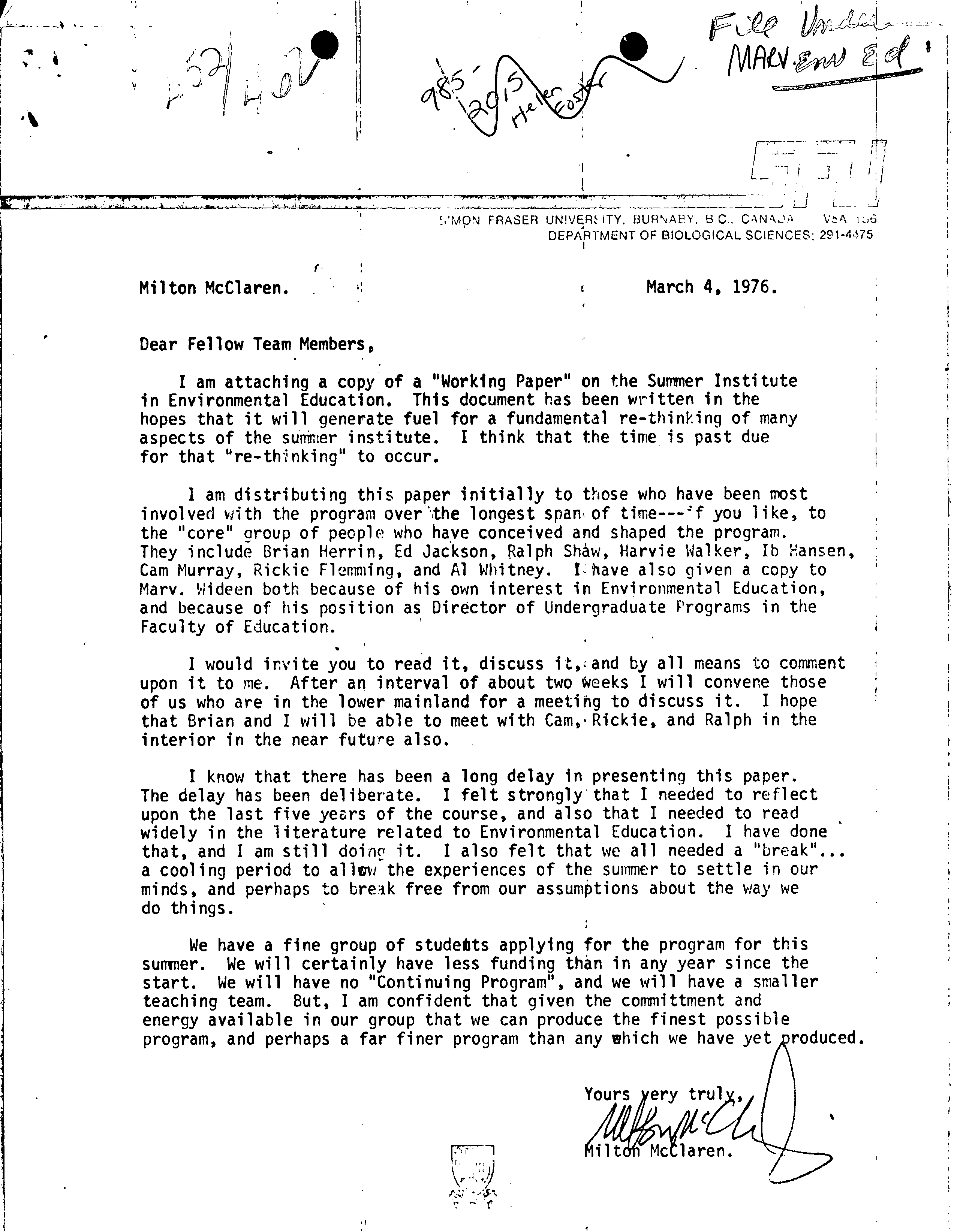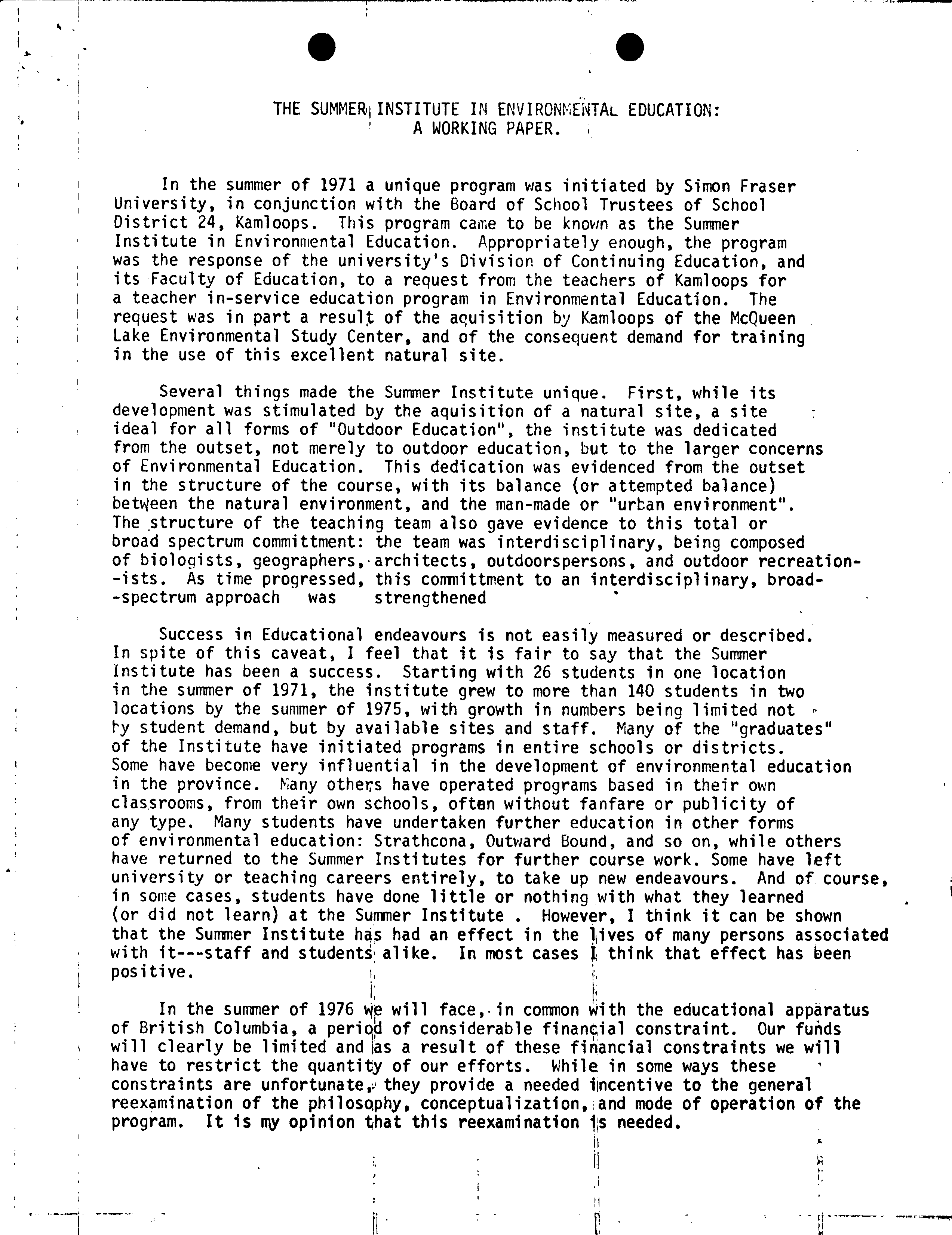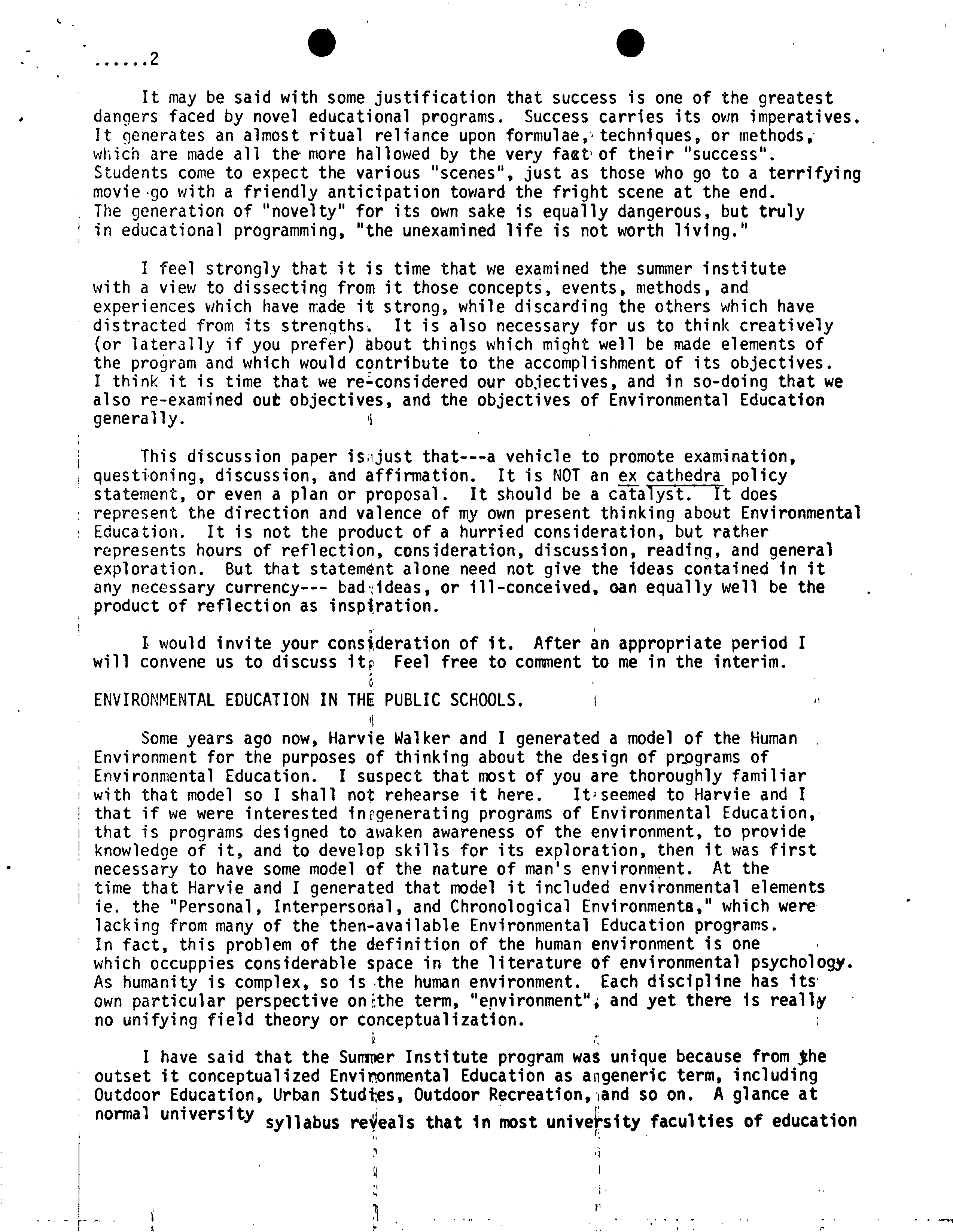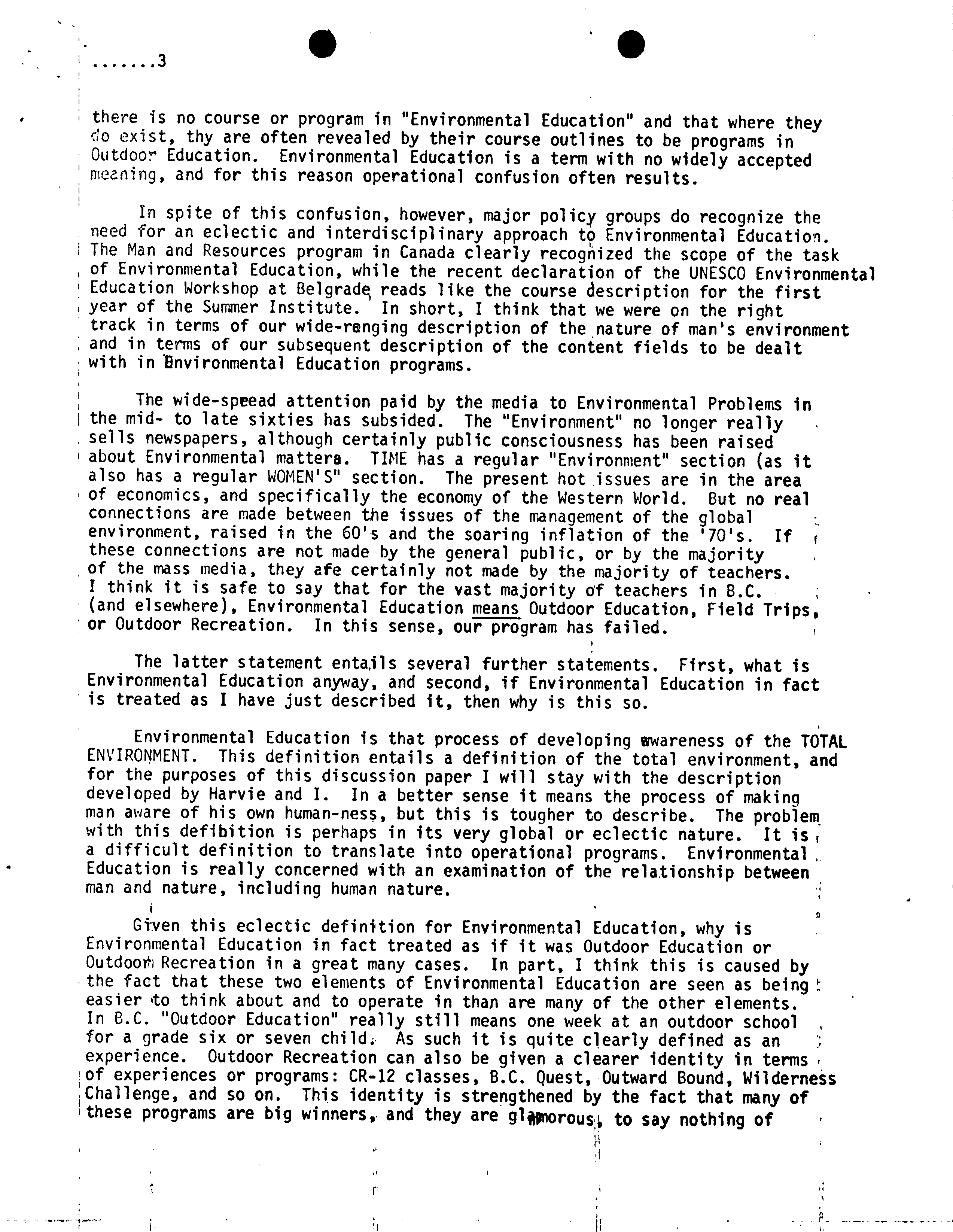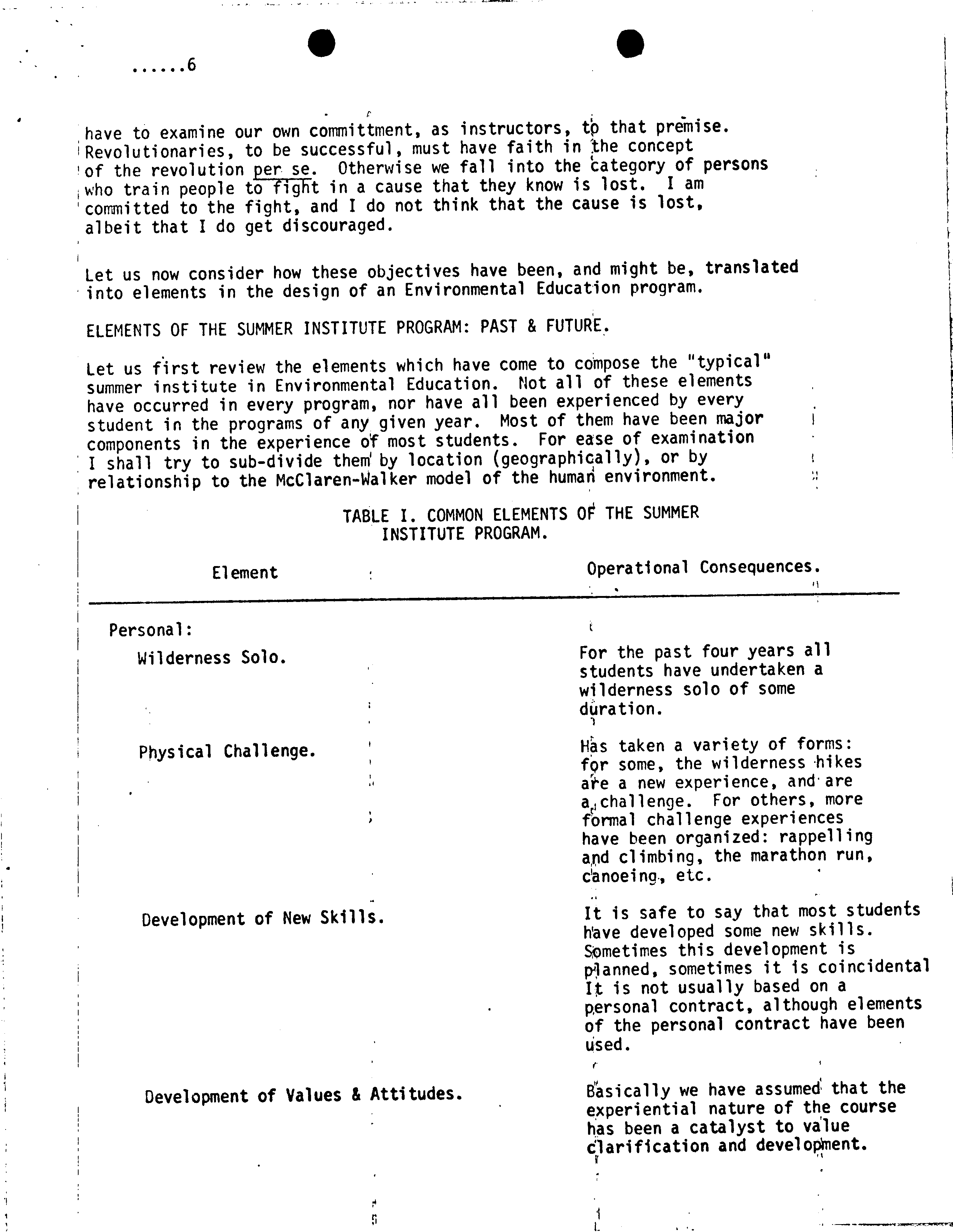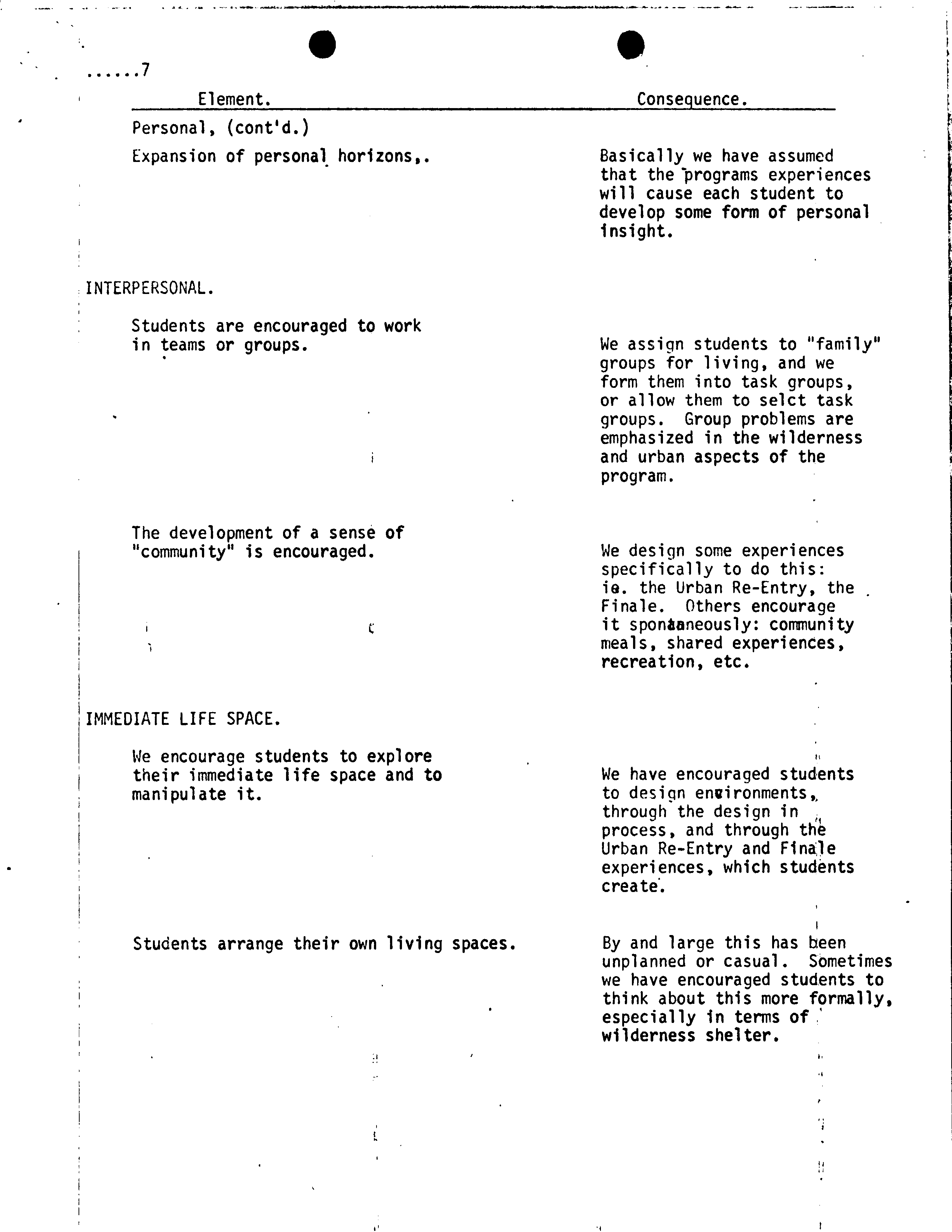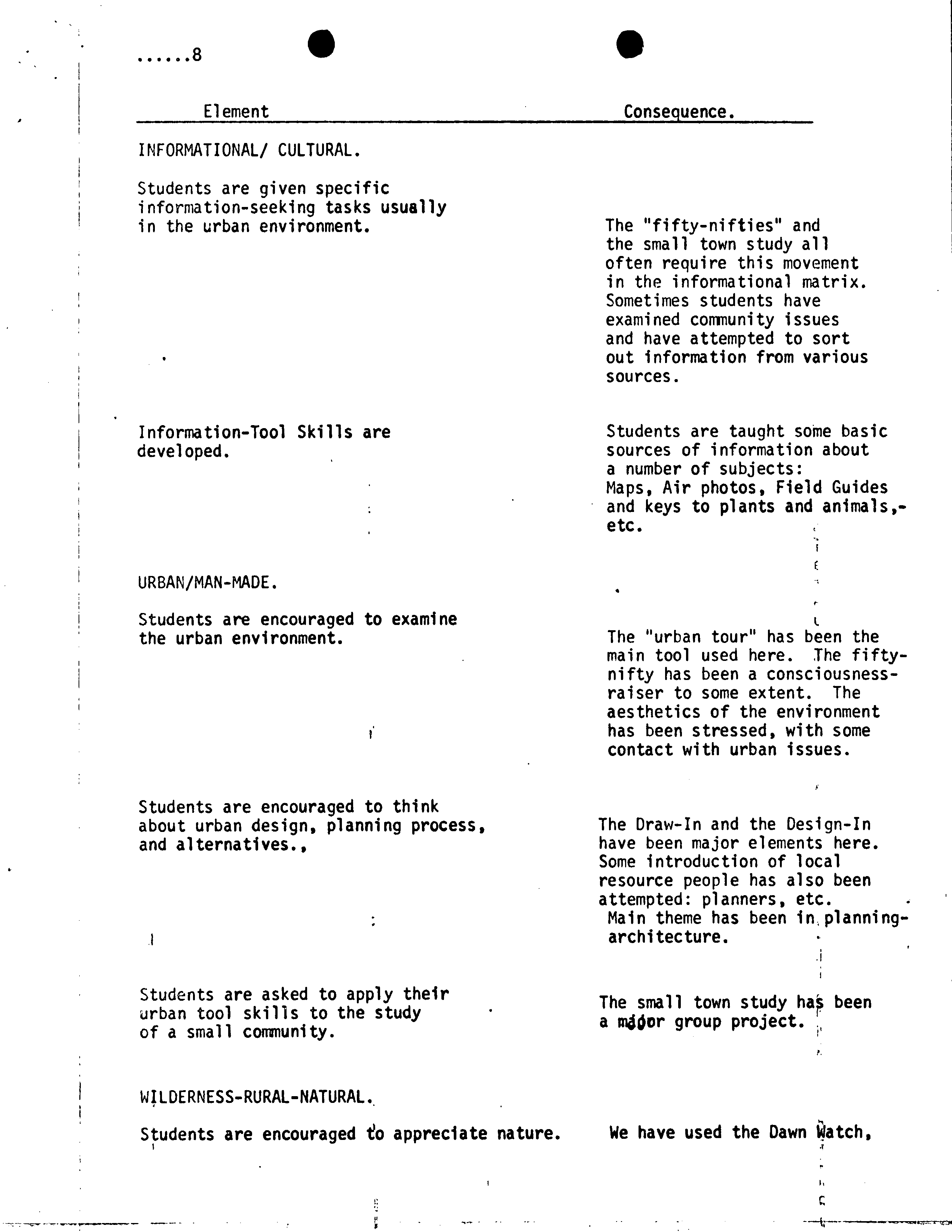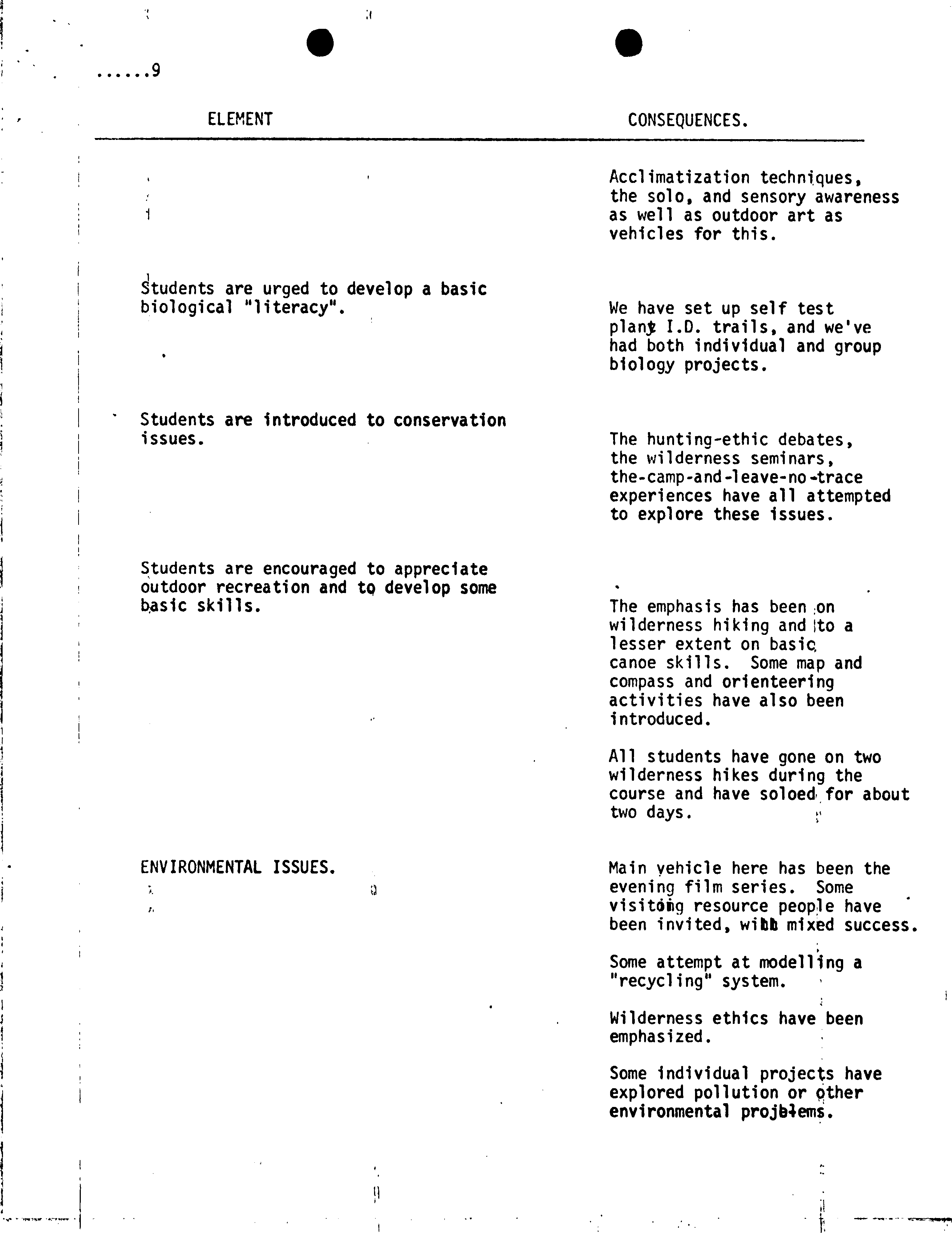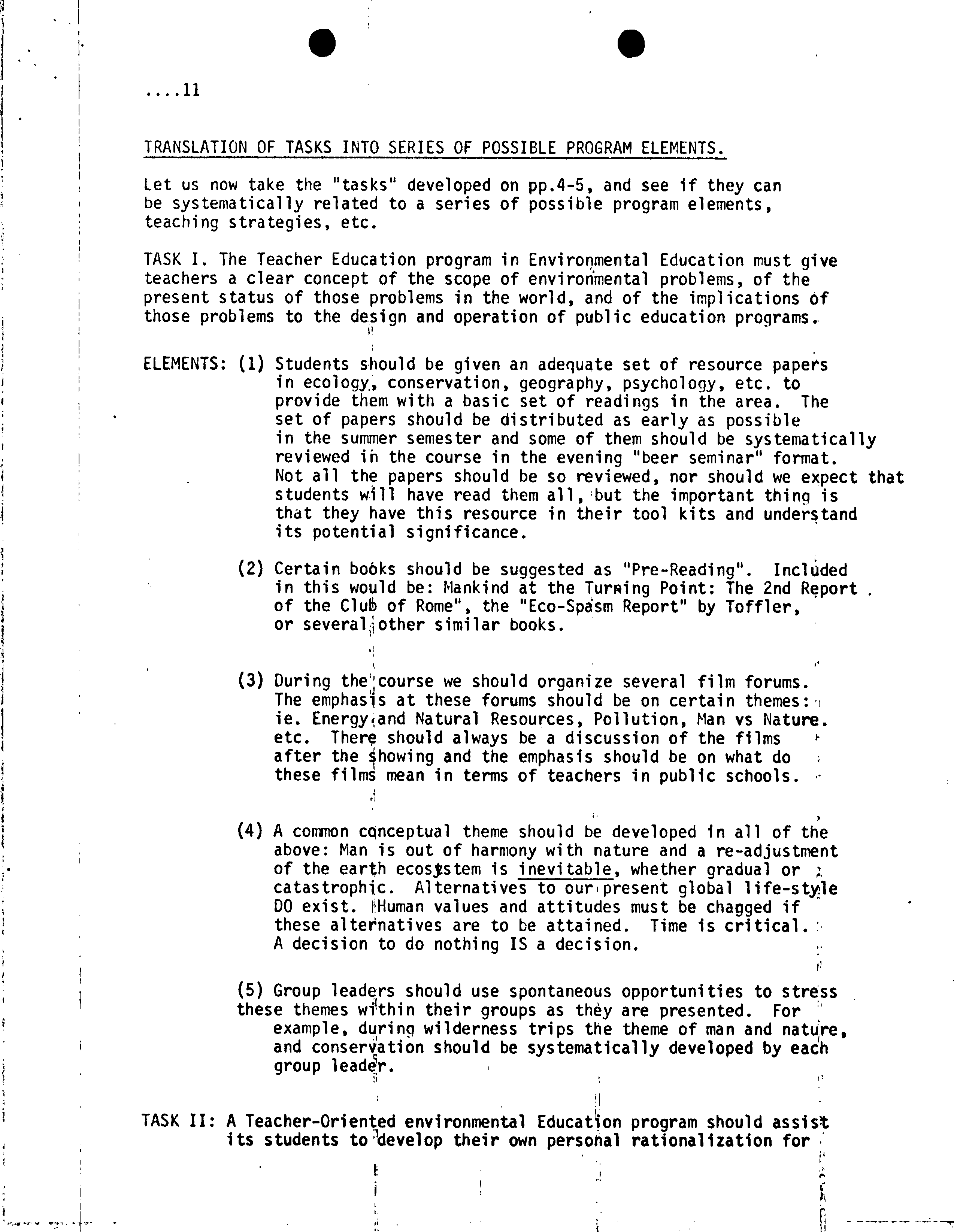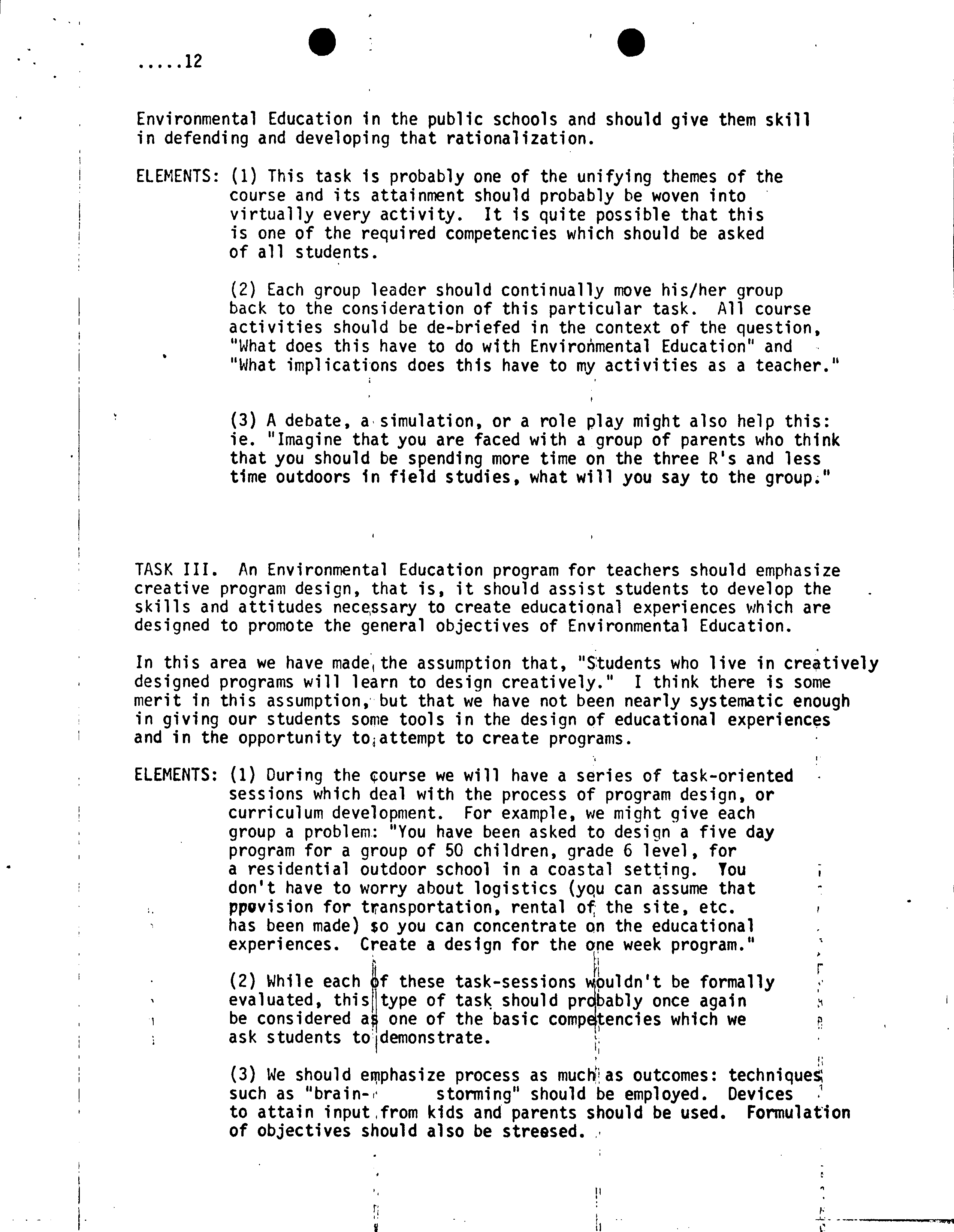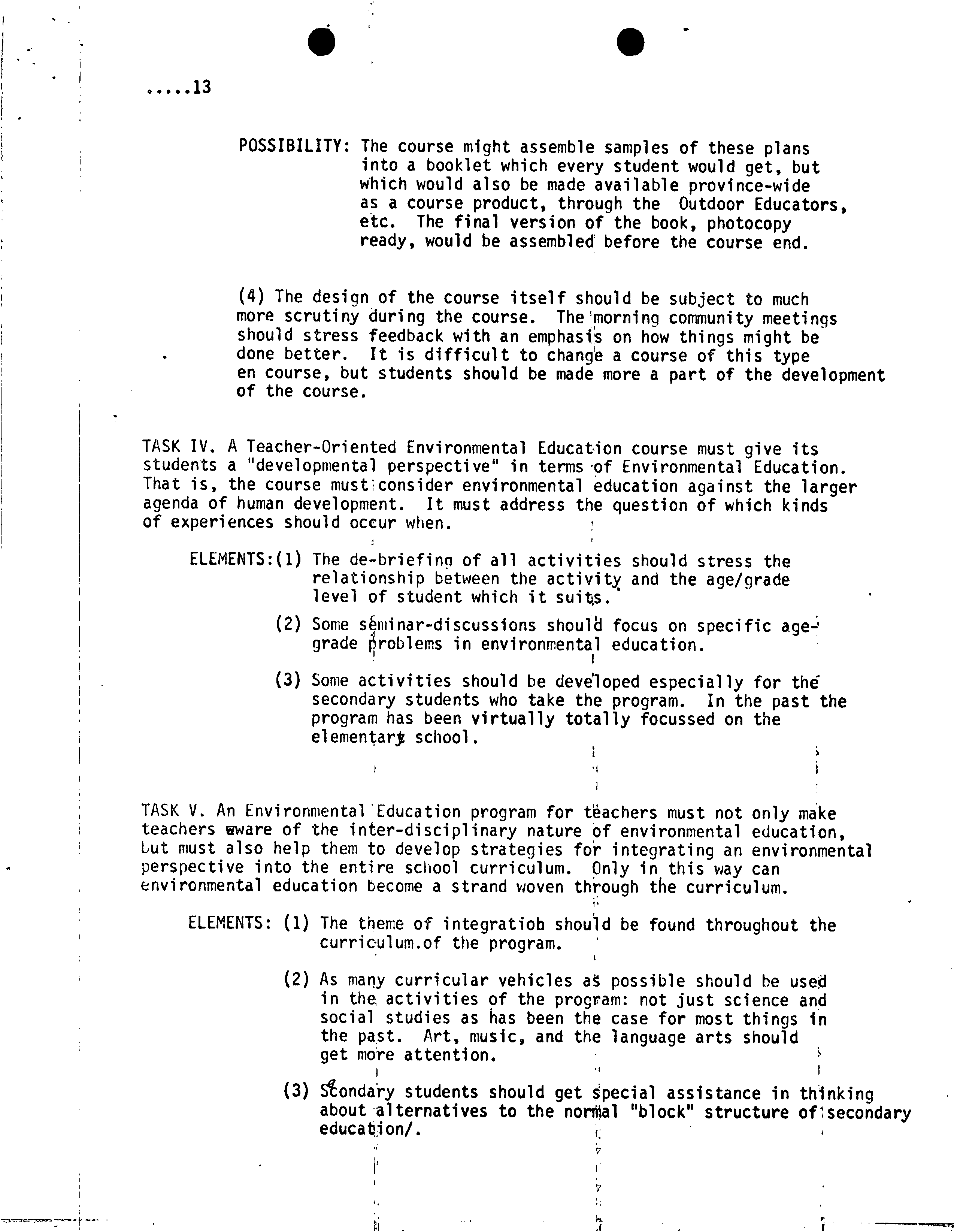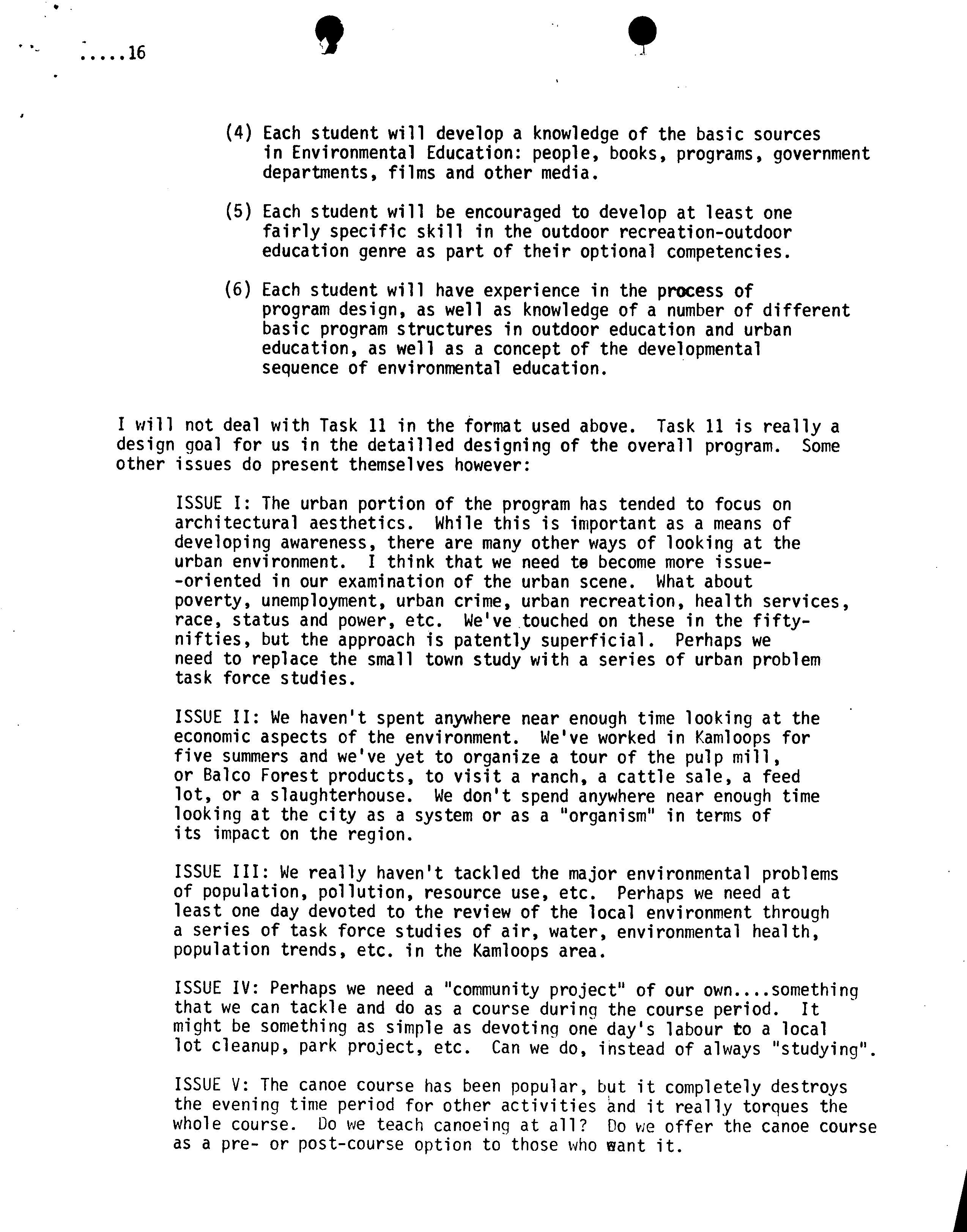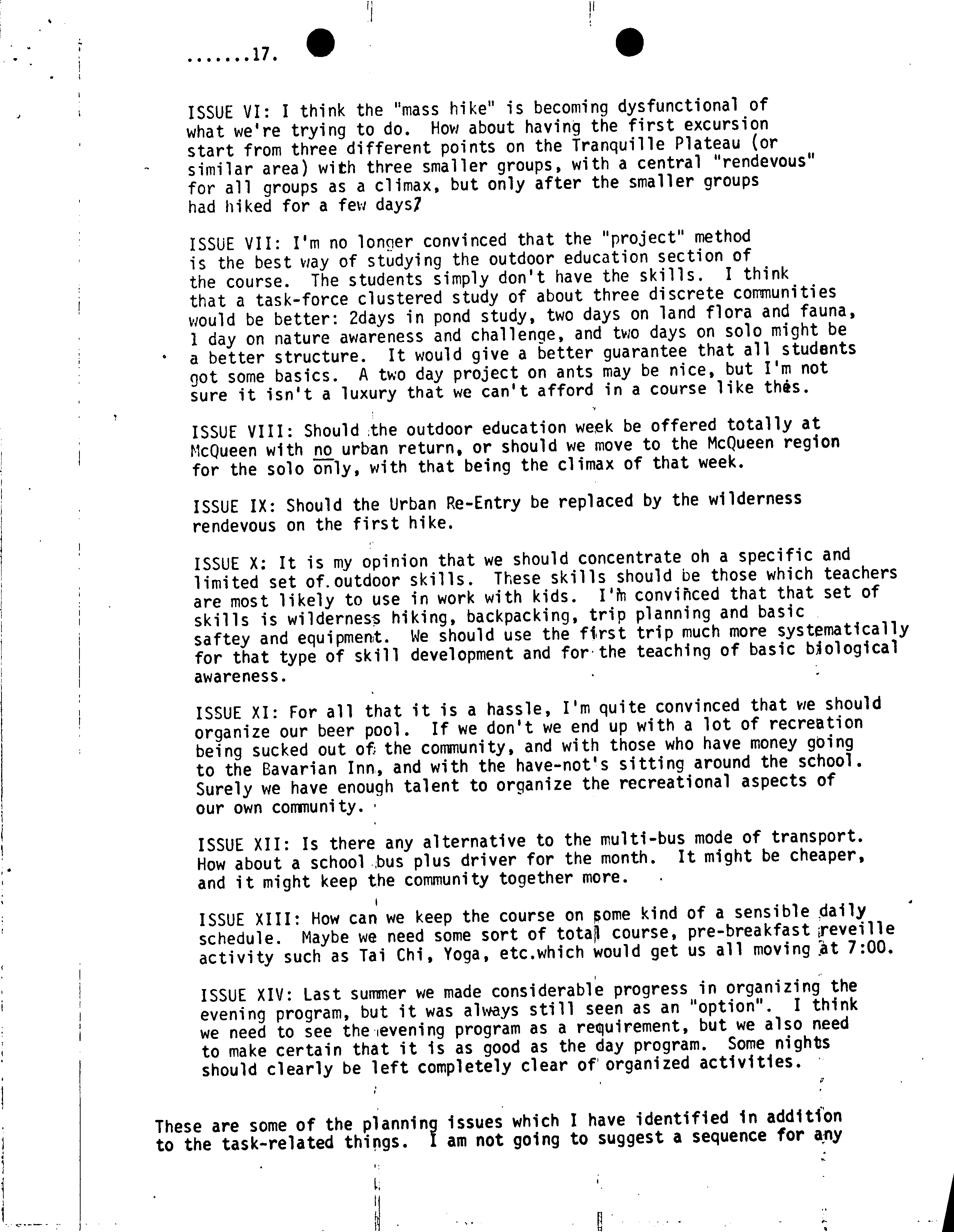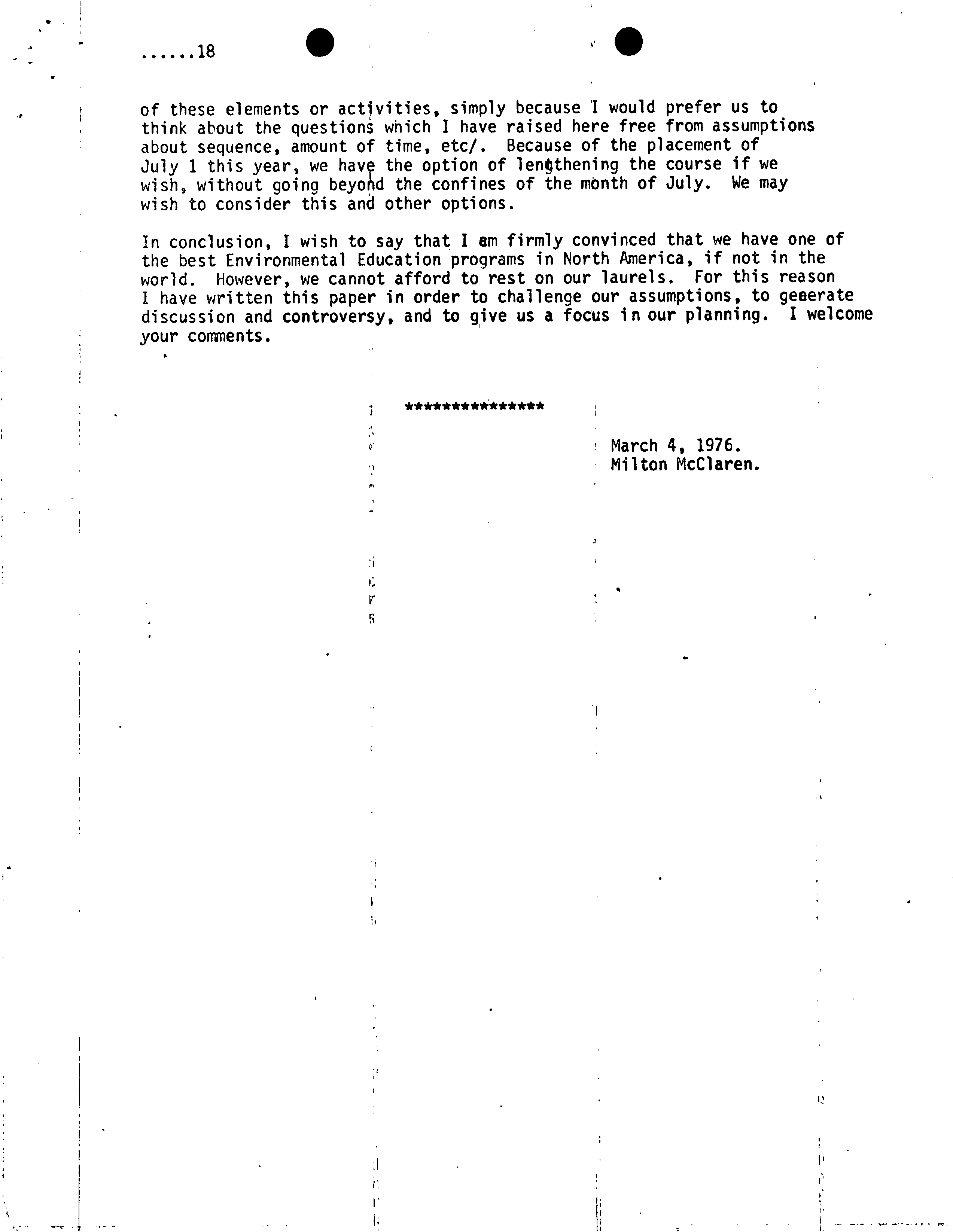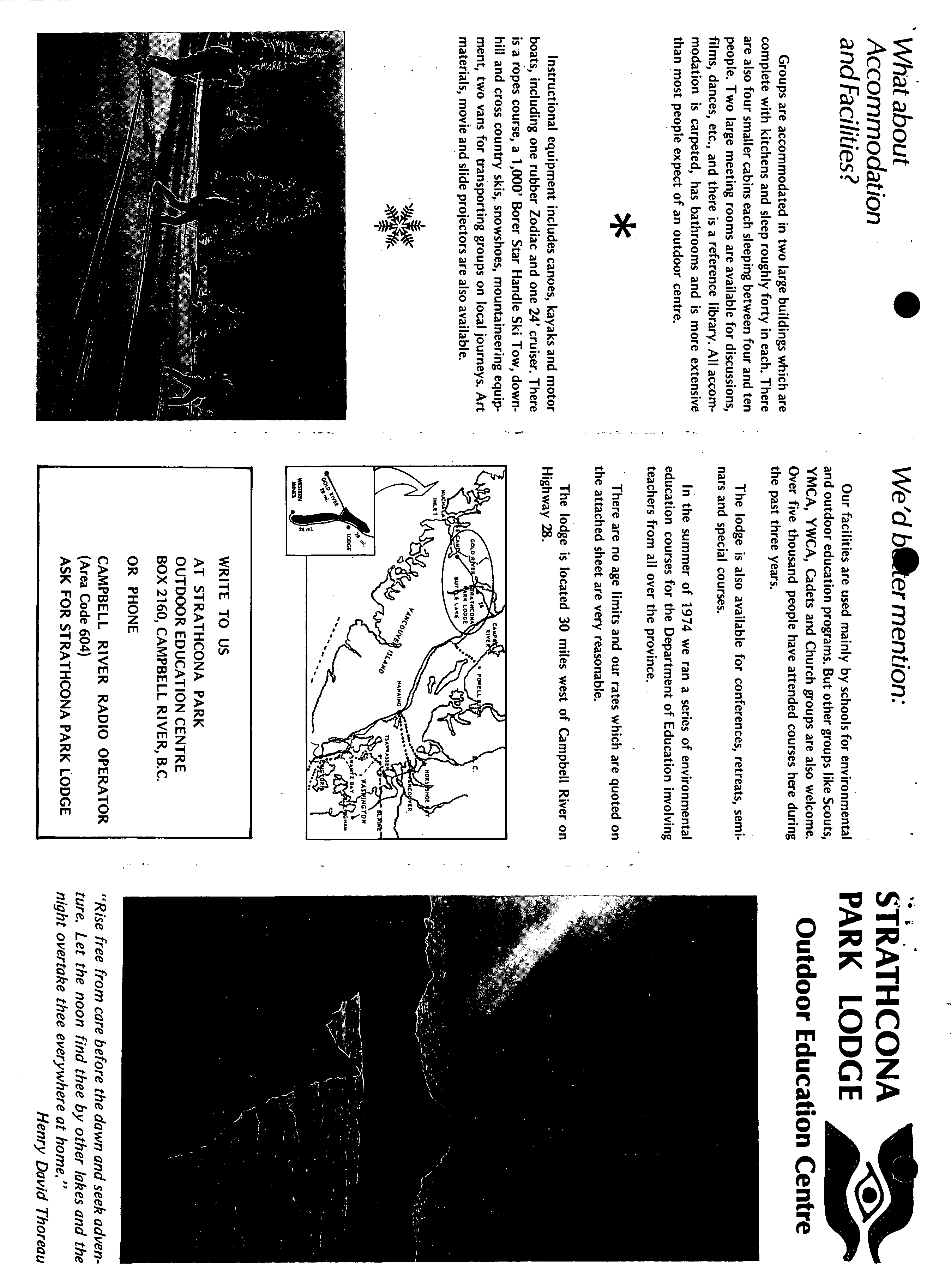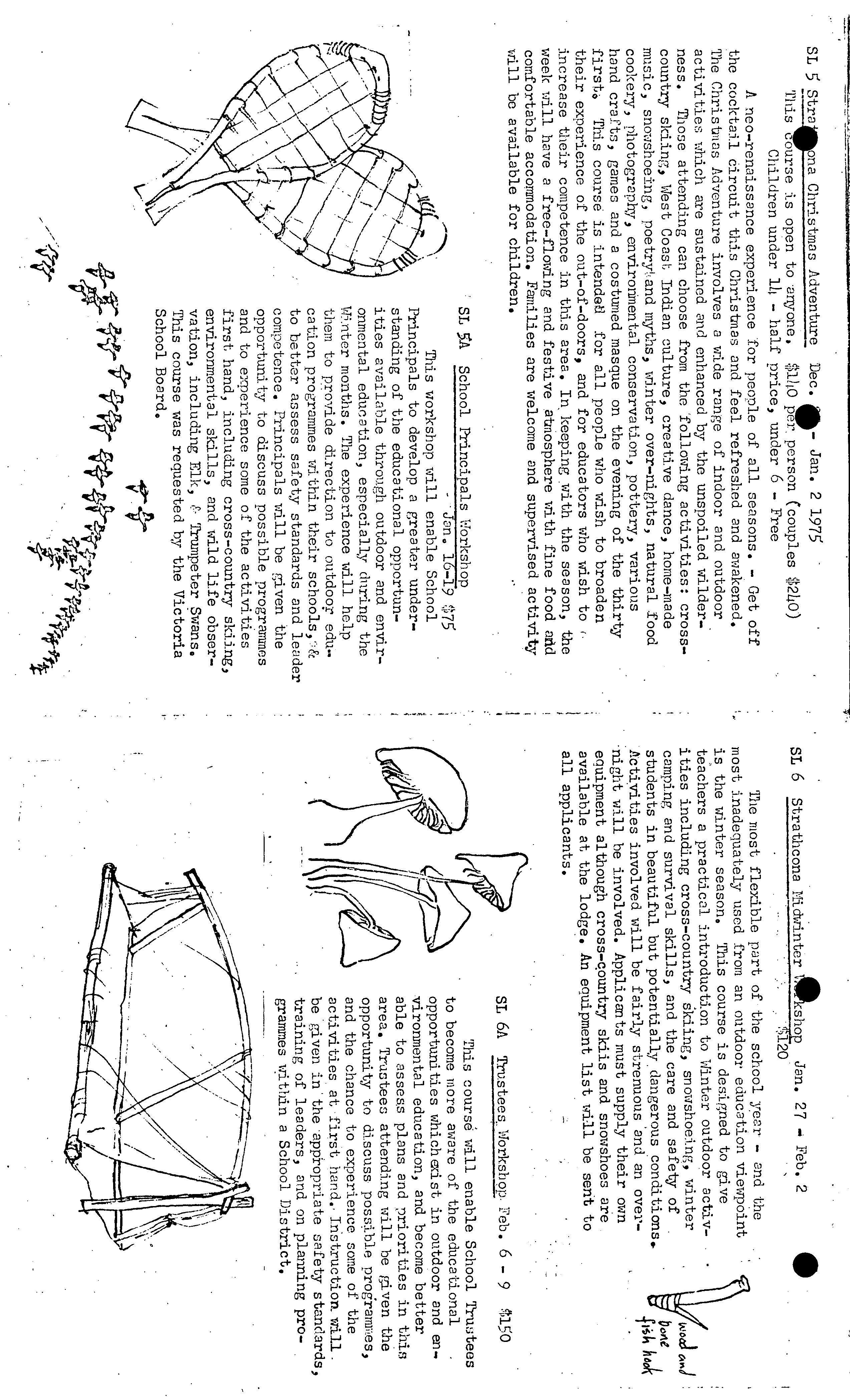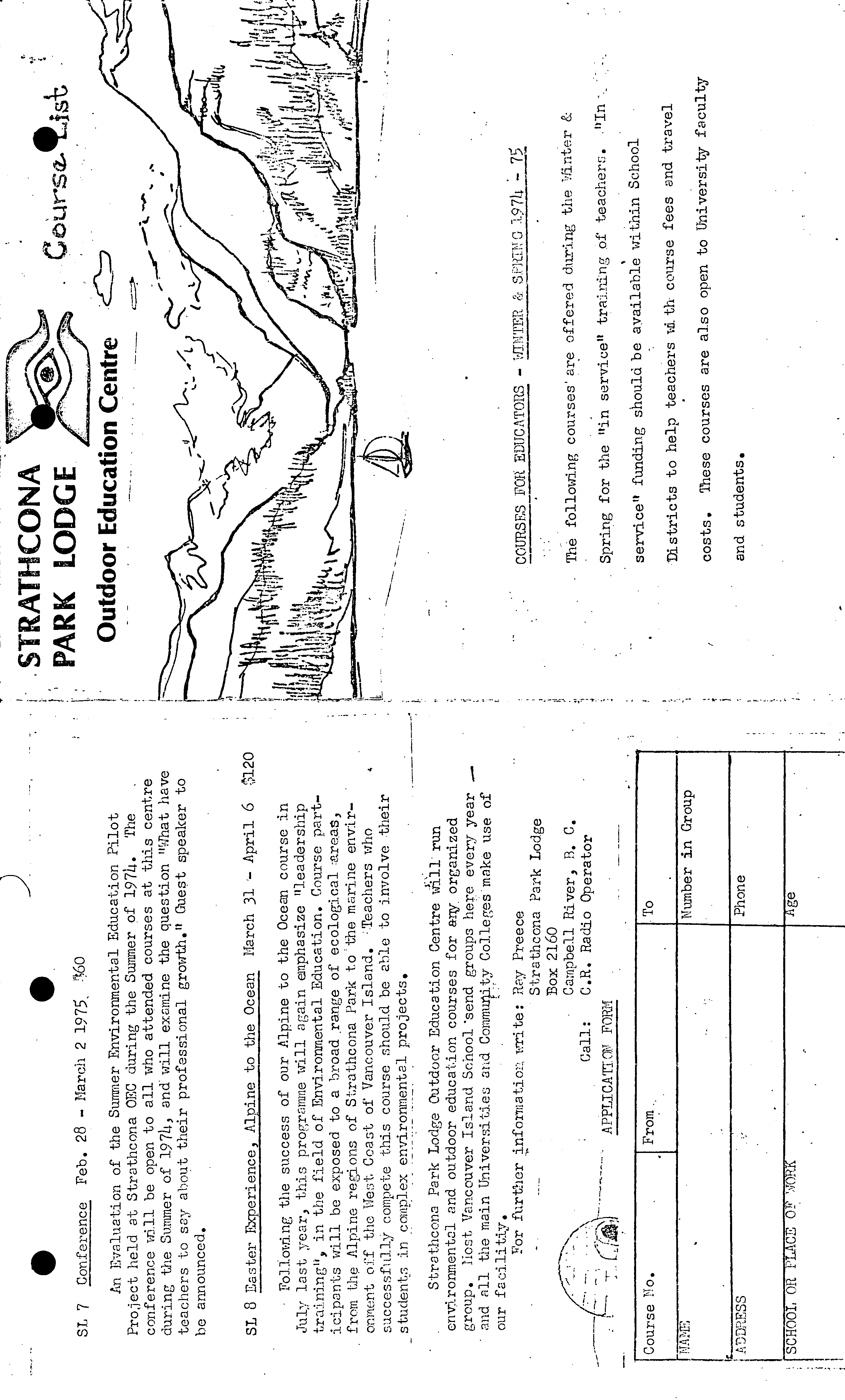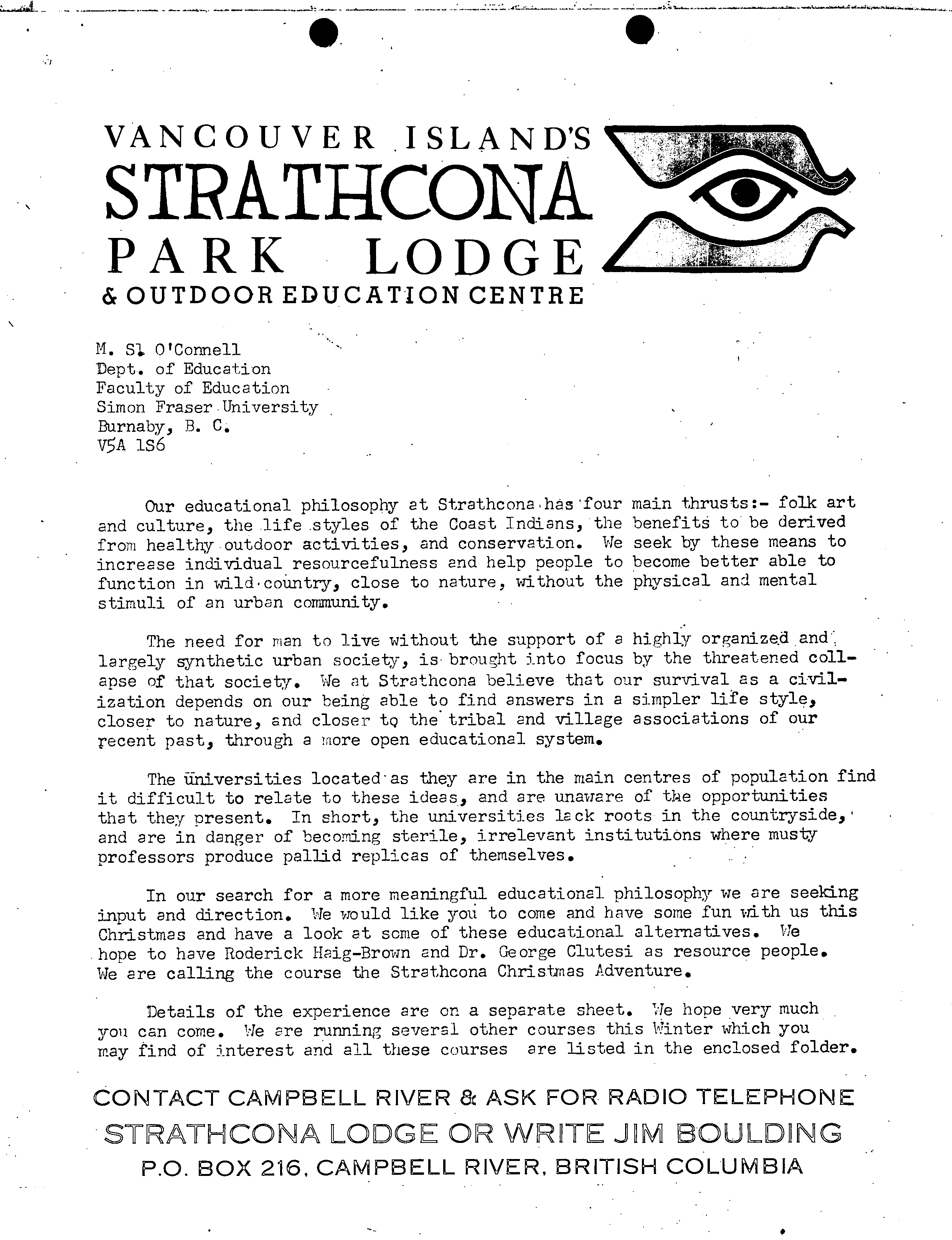Xle
?
L_.
7! ?
J
) ?
I
?
Li ?
L ?
J
.MpN FRASER UNIVER
L
ITY. BUFNAY, B C., CANA.J
?
VA ..
• ?
OEPAPTMENT OF BIOLOGICAL SCIENCES: 21-4475
Milton McClaren.
?
March 4, 1976.
Dear Fellow Team Members,
I am attaching a copy of a "Working Paper" on the Summer Institute
in Environmental Education. This document has been written in the
hopes that it will generate fuel for a fundamental re-thinking of many
aspects of the summer institute. I think that the time is past due
for that "re-thinking" to occur.
I am distributing this paper initially to those who have been most
involved with the program over the longest spans of
time-_-f
you like, to
the "core" group of people who have conceived and shaped the program.
They include Brian Herrin, Ed Jackson, Ralph Shàw, Harvie Walker, lb Xansen,
Cam Murray, Rickic Flemming, and Al Whitney. !have also given a copy to
Mar y
. Wideen both because of his own interest in Environmental Education,
and because of his position as Director of Undergraduate Programs in the
Faculty of Education.
I would ir.vite you to read it, discuss lt,and by all means to comment
upon it to me. After an interval of about two weeks I will convene those
of us who are in the lower mainland for a meeting to discuss it. I hope
that Brian and I will be able to meet with Cam, Rickie, and Ralph in the
interior in the near future also.
I know that there has been a long delay in presenting this paper.
The delay has been deliberate. I felt strongly that I needed to reflect
upon the last five years of the course, and also that I needed to read
widely in the literature related to Environmental Education. I have done
that, and I am still doino it. I also felt that we all needed a "break"...
a cooling period to allow the experiences of the summer to settle in our
minds, and perhaps to bre,ik free from our assumptions about the way we
do things.
We have a fine group of studedts applying for the program for this
summer. We will certainly have less funding than in any year since the
start. We will have no "Continuing Program", and we will have a smaller
teaching team. But, I am confident that given the committment and
energy available in our group that we can produce the finest possible
program, and perhaps a far finer program than any which we have yet produced.
N
Yours
ilt
ery
mce
t rul
F_
THE SUMMER1 INSTITUTE IN ENVIRONEEiTAL EDUCATION:
A WORKING PAPER.
In the summer of 1971 a unique program was Initiated by Simon Fraser
University, in conjunction with the Board of School Trustees of School
District 24, Kamloops. This program came to be known as the Summer
Institute in Environmental Education. Appropriately enough, the program
was the response of the university's Division of Continuing Education, and
its Faculty of Education, to a request from the teachers of Kamloops for
a teacher in-service education program in Environmental Education. The
request was in part a result of the aquisition by Kamloops of the McQueen
Lake Environmental Study Center, and of the consequent demand for training
in the use of this excellent natural site.
Several things made the Summer Institute unique. First, while its
development was stimulated by the aquisition of a natural site, a site
ideal for all forms of "Outdoor Education", the institute was dedicated
from the outset, not merely to outdoor education, but to the larger concerns
of Environmental Education. This dedication was evidenced from the outset
in the structure of the course, with its balance (or attempted balance)
betteen the natural environment, and the man-made or "urban environment".
The
•
structure of the teaching team also gave evidence to this total or
broad spectrum committment: the team was interdisciplinary, being composed
of biologists, geographers,architects, outdoorspersons, and outdoor recreation-
-ists. As time progressed, this conmittment to an interdisciplinary, broad-
-spectrum approach was ?
strengthened
Success in Educational endeavours is not easily measured or described.
In spite of this caveat, I feel that it is fair to say that the Summer
Institute has been a success. Starting with 26 students in one location
in the summer of 1971, the institute grew to more than 140 students in two
locations by the summer of 1975, with growth in numbers being limited not
y student demand, but by available sites and staff. Many of the "graduates"
of the Institute have initiated programs in entire schools or districts.
Some have become very influential in the development of environmental education
in the province. Many others have operated programs based in their own
classrooms, from their own schools, often without fanfare or publicity of
any type. Many students have undertaken further education in other forms
of environmental education: Strathcona, Outward Bound, and so on, while others
have returned to the Summer Institutes for further course work. Some have left
university or teaching careers entirely, to take up new endeavours. And of course,
in some cases, students have done little or nothing with what they learned
(or did not learn) at the Summer Institute . However, I think it can be shown
that the Summer Institute has had
an
effect in the
I l
ives of
many persons associated
with it---staff and students alike. In most cases
I.
think that effect has been
positive.
In the summer of 1976 ?
will face,.in common with the educational apparatus
of British Columbia, a periØ of considerable finanial constraint. Our fuds
will clearly be limited and as a result of these financial constraints we will
have to restrict the quantity of our efforts. While in some ways these
constraints are unfortunate, they provide a needed lincentive to the general
reexamination of the philosophy, conceptualization,and mode
of operation of the
program. It Is
my
opinion
that this reexamination
1s
needed.
p
- ?
- ....,.2 ?
.
?
.
It may be said with some justification that success is one of the greatest
dangers faced by novel educational programs. Success carries its own imperatives.
It generates an almost ritual reliance upon formulae,' techniques, or methods,
which are made all the more hallowed by the very fat of their "success".
Students come to expect the various "scenes", just as those who go to a terrifying
movie go with a friendly anticipation toward the fright scene at the end.
The generation of "novelty" for its own sake is equally dangerous, but truly
in educational programming, "the unexamined life is not worth living."
I feel strongly that it is time that we examined the summer institute
with a view to dissecting from it those concepts, events, methods, and
experiences which have nade It strong, while discarding the others which have
distracted from its strengths. It is also necessary for us to think creatively
(or laterally if you prefer) about things which might well be made elements of
the program and which would contribute to the accomplishment of its objectives.
I think it is time that we re-considered our objectives, and in so-doing that we
also re-examined out objectives, and the objectives of Environmental Education
generally.
This discussion paper isijust that --- a vehicle to promote examination,
questioning, discussion, and affirmation. It is NOT an ex cathedra policy
statement, or even a plan or proposal. It should be a catalyst. It does
represent the direction and valence of my own present thinking about Environmental
Education. It is not the product of a hurried consideration, but rather
represents hours of reflection, consideration, discussion, reading, and general
exploration. But that statement alone need not give the ideas contained in it
any necessary currency--- bad:ldeas, or ill-conceived, oan equally well be the
product of reflection as inspiration.
I would invite your
cons*deration
of it. After an appropriate period I
will convene us to discuss itp Feel free to comment to me in the interim.
ENVIRONMENTAL EDUCATION IN THE PUBLIC SCHOOLS.
Some years ago now, Harvie Walker and I generated a model of the Human
Environment for the purposes of thinking about the design of programs of
Environmental Education. I suspect that most of you are thoroughly familiar
With that model so I shall not rehearse it here.
?
Itseemed to Harvie and I
that if we were interested ingenerating programs of Environmental Education,'
I
that is programs designed to awaken awareness of the environment, to provide
knowledge of it, and to develop skills for its exploration, then it was first
necessary to have some model of the nature of man's environment. At the
time that Harvie and I generated that model it included environmental elements
ie. the "Personal, Interpersonal, and Chronological Environmenta," which were
lacking from many of the then-available Environmental Education programs.
In fact, this problem of the definition of the human environment is one
which occuppies considerable space in the literature of environmental psychology.
As humanity is complex, so is the human environment. Each discipline has its
own particular perspective on E
the term, "environment", and yet there is really
no unifying field theory or conceptualization.
I have said that the Sumer Institute program was unique because from he
outset it conceptualized Environmental Education as aiigeneric term, including
Outdoor Education, Urban
Studtes,
Outdoor Recreation, and so on. A glance at
normal university syllabus reeals that
In most unive'sity faculties
of education
S
there is no course or program in "Environmental Education" and that where they
10 exist, thy are often revealed by their course outlines to be programs in
Outdoor Education. Environmental Education is a term with no widely accepted
meaning, and for this reason operational confusion often results.
In spite of this confusion, however, major policy groups do recognize the
need for an eclectic and interdisciplinary approach to Environmental Education.
The Man and Resources program in Canada clearly recognized the scope of the task
of Environmental Education, while the recent declaration of the UNESCO Environmental
Education Workshop at Belgrad reads like the course description for the first
year of the Summer Institute. In short, I think that we were on the right
track in terms of our wide-ranging description of the nature of man's environment
and in terms of our subsequent description of the content fields to be dealt
with in Bnvironmental Education programs.
The wide-speead attention paid by the media to Environmental Problems In
the mid- to late sixties has subsided. The "Environment" no longer really
sells newspapers, although certainly public consciousness has been raised
about Environmental mattera. TIME has a regular "Environment" section (as it
also has a regular WOMEN'S" section. The present hot issues are in the area
of economics, and specifically the economy of the Western World. But no real
connections are made between the issues of the management of the global
environment, raised in the 60's and the soaring inflation of the '70's. If
these connections are not made by the general public,or by the majority
of the mass media, they afe certainly not made by the majority of teachers.
I think it is safe to say that for the vast majority of teachers in B.C.
(and elsewhere), Environmental Education means Outdoor Education, Field Trips,
or Outdoor Recreation. In this sense, our program has failed.
The latter statement entails several further statements. First, what is
Environmental Education anyway, and second, if Environmental Education in fact
is treated as I have just described it, then why is this so.
Environmental Education is that process of developing wwareness of the TOTAL
ENVIRONMENT. This definition entails a definition of the total environment, and
for the purposes of this discussion paper I will stay with the description
developed by Harvie and I. In a better sense it means the process of making
man aware of his own human-ness, but this is tougher to describe. The problem
with this defibition is perhaps in its very global or eclectic nature. It is
a difficult definition to translate into operational programs. Environmental
Education is really concerned with an examination of the relationship between
man and nature, including human nature.
Given this eclectic definition for Environmental Education, why is
Environmental Education in fact treated as if it was Outdoor Education or
Outdoo, Recreation in a great many cases. In part, I think this is caused by
the fact that these two elements of Environmental Education are seen as being
easier 'to think about and to operate In than are many of the other elements.
In B.C. "Outdoor Education" really still means one week at an outdoor school
for a grade six or seven child.. As such it is quite
clearly
defined as an
experience. Outdoor Recreation can also be given a clearer identity in terms
of experiences or programs: CR-12 classes, B.C. Quest, Outward Bound, Wilderness
Challenge, and so on. This identity is strengthened by the fact that many of
these programs are big winners, and they are
gl
Pnorous to say nothing of
'.4 ?
..
photogenic. They excite the attention of the media and of School District
Public Relations people. We all have, and have seen, photos of kids against
breath-taking mountain scenary. It is all very
"
clean
" and "active" and
"healthy". Contrasted to the Minimata victim stumbling down the village
street dribbling they have clear appeal to the average man (or parent).
It is hardly suprising, therefore, that we have tended to concentrate on
our "easy winners".
There is, however, another reason for our specific attention to the
Outdoor portions of the Environmental Education spectrum. This is that
some of the other areas Qf environmental education are controversial, or
at least, not ni'e or proper for the consideration of school students.
Many parents would far rather see their sons or daughters dangling from a
Cliff )
than interviewing welfare recipients in an urban slum project.
Uneasy fathers don't want their sons and daughters probing the airpollution
produced by the local mill ("they aren't old enough to understand") let alone
would they be delighted if the kids were to initiate a class action civic
damage suit. And yet these are probably the real priority areas of Environmental
Education.
But if these facts are true for the emses of Public School programs
they are equaLLy true for ourown program. We too have emphasized the "easy"
and attractive components of environmental education, perhaps not to the
exclusion of controversy and issues, but certainly to the point where these
elements have become increasingly dominant. Let's face It, we too are human.
I like being in the alpine, and being out among the birds, flowers, and forests
and lakes of McQueen Lake. I.can appreciate Kamloops as a city at one level,
but I'm really avoiding many 6ther aspects of the total nature of the relationship
between man and his environment.
It is time that we re-affirmed our committnient to a more global view
of Environmental Education and that we set out to emulate that comitt.ment in
our program's design and operation.
WHAT ARE THE TASKS OF A TEACHER EDUCATION PROGRAM IN ENVIRONMENTAL EDUCATION?
T
his is the key question which we must consider if we are to avoid trying
to be "all things to all men" in our program. I shall discuss this question
within the context of Environmental Education as I have defined it and from
the perspective of the issues which I have already raised.
(1)
A Teacher Education program in Environmental Education must give teachers a
clear concept of the scope of Environmental Problems,-of the present status of
those problems in the world, and of the implications of those problems to the
design and operation of public education programs.
(2)
A Teacher-Oriented Environmental Education program should assist its students
to develop their own personal retionalization for environmental education in the
public schools, and should give them skill in defending and developing that
'ationAl ization.
(3) An Environmental Educatior t
program for teachers should emphasize creative
program design, that
is It
should assist students to develop the skills and
attitudes necessary to create educational experiences which are designed to
promote the general objectives of Environmental Education.
(4)
A Teacher-Oriented Environmental Education program must give its students
a "developmental perspective" in terms of Environmental Education. That is,
the program must consider environmental education against the larger agenda
of human development. It must address the question of which kinds of
experiences should occur when.
(5)
An Environmental Education program for teachers must not only make teachers
aware of the inter-disciplinary nature of Environmental Education, but must
also help them to develop strategies for integrating an Environmental perspective
into the entire school curriculum. Only in this way can Environmental Education
become a "strand" woven through the curriculum.
(6)
Any Environmental Education program must assist its students to examine
and to clarify their own environmental values, attitudes, and behaviours.
(7)
The program should help the teacher to see himself as a lifelong learnbr,
and should enable him to take an inventory of his own- skills, knowledge,
and techniques.
(2) A Teacher-oriented environmental education program should help teachers
to understand the relative position and power of formal education in the total
spectrum of learning-teaching forces which act upon human beings in contemporary
society: the media, mass advertising, government action
%
etc.
n
(9)
Environmental Education pro
gr a ms
for teachers shquld help teachers to develop
and to affirm their personal çommittment to environmental action.
(10)
Environmental Education programs for teachers should give students a
lexicon of saleable, success-proven teaching strategies and program designs
in Environmental Education ata variety of age/grade levels.
(11)
Environmental EducatiOn programs should be powerfful personal experiences
for the learners involved, staff and students, and they should embody in their
design the foregoing principles.
These eleven points represeet the most concise statement of objectives
for environmental education programs for teachers which I could develop. They
are not in any particular order of importance --- number eleven is perhaps an
over-riding consideration or is a design criterion more than an objective.
Another underlying state nent which should be made at this point is this:
The Environmental problems facing the world are serious. Time is short.
If we are to reach some sort of human solution to these problems, rather than
one brought about by eco-catastrophe, then we have
td
treat these problems
as though they were in fact seriope. -I think that all of us share some ambivalence
about public schools in terms of their effectiveness,and in terms of what
they do to kids and to teachers. I think that we communicate that ambivalenCe
to our students and they in turn extend this into their own style of operatibn.
I doubt the effectiveness of schools in their present form in dealing with
any social issue --- but I am committed to the idea that too much human energy
and resources are tied up intpublic education to scrap that system. We
.6 ?
. ?
S
have to examine our own comniittment, as instructors, t that premise.
Revolutionaries, to be successful, must have faith in :the concept
of the revolution per Se. Otherwise we fall into the category of persons
who train people to fight in a cause that they know is lost. I am
'committed to the fight, and I do not think that the cause is lost,
albeit that I do get discouraged.
Let us now consider how these objectives have been, and might be, translated
into elements in the design of an Environmental Education program.
ELEMENTS OF THE SUMMER INSTITUTE PROGRAM: PAST & FUTURE.
Let us first review the elements which have come to compose the 'typical"
summer institute in Environmental Education. Not all of these elements
have occurred in every program, nor have all been experienced by every
student in the programs of any given year. Most of them have been major
components in the experience of most students. For ease of examination
I shall try to sub-divide them by location (geographically), or by
relationship to the McClaren-Walker model of the human' environment.
TABLE I. COMMON ELEMENTS Ol THE SUMMER
INSTITUTE PROGRAM.
Element ?
Operational Consequences.
Personal:
Wilderness Solo.
?
For the past four years all
tiu1 p
ntc
have undertaken a
wilderness solo of some
duration.
Physical Challenge.
?
Has taken a variety of forms:
for some, the wilderness hikes
a'e a new experience, and are
achal1enge. For others, more
Formal challenge experiences
have been organized: rappelling
ard climbing, the marathon run,
canoeing, etc.
Development of New Skills.
Development of Values & Attitudes.
It is safe to say that most students
have developed some new skills.
Sometimes this development is
pianned, sometimes it is coincidental
It is not usually based on a
personal contract, although elements
of the personal contract have been
Used.
Basically we have assumed that the
experiential nature of the course
has been a catalyst to value
Clarification and develoient.
S ?
S
7
Element. ?
Consequence.
Personal, (cont'd.)
Expansion of personal horizons,.
?
Basically we have assumed
that the programs experiences
will cause each student to
develop some form of personal
insight.
INTERPERSONAL.
Students are encouraged to work
in teams or groups.
The development of a sense of
community" is encouraged.
C
IMMEDIATE LIFE SPACE.
We encourage students to explore
their immediate life space and to
manipulate it.
We assign students to "family"
groups for living, and we
form them into task groups,
or allow them to selct task
groups. Group problems are
emphasized in the wilderness
and urban aspects of the
program.
We design some experiences
specifically to do this:
ie. the Urban Re-Entry, the
Finale. Others encourage
it spontaneously: community
meals, shared experiences,
recreation, etc.
We have encouraged students
to design environments,,
through the design in
process, and through the
Urban Re-Entry and Finale
experiences, which students
create.
Students arrange their own living spaces.
By and large this has been
unplanned or casual. Sometimes
we have encouraged students to
think about this more formally,
especially in terms of
wilderness shelter.
. 8
?
.
?
S
Element ?
Consequence.
INFORMATIONAL! CULTURAL.
Students are given specific
information-seeking tasks usually
in the urban environment.
Information-Tool Skills are
developed.
The "fifty-nifties" and
the small town study all
often require this movement
in the informational matrix.
Sometimes students have
examined community issues
and have attempted to sort
out information from various
sources.
Students are taught some basic
sources of information about
a number of subjects:
Maps, Air photos, Field Guides
and keys to plants and animals,-
etc.
URBAN/MAN-MADE.
Students are encouraged to examine
the urban environment.
Students are encouraged to think
about urban design, planning process,
and alternatives.,
Students are asked to apply their
urban tool skills to the study
of a small community.
WILDERNESS-RURAL-NATURAL..
Students are encouraged to appreciate nature.
I-
The "urban tour" has been the
main tool used here. The fifty-
nifty has been a consciousness-
raiser to some extent. The
aesthetics of the environment
has been stressed, with some
contact with urban issues.
The Draw-In and the Design-In
have been major elements here.
Some introduction of local
resource people has also been
attempted: planners, etc.
Main theme has been in planning-
architecture.
The small town study ha been
a
m4*or
group project.
We have used the Dawn iatch,
[i
?
S
.9
ELEMENT ?
CONSEQUENCES.
Acclimatization techniques,
the solo, and sensory awareness
as well as outdoor art as
vehicles for this.
S'tudents are urged to develop a basic
biological "literacy".
Students are introduced to conservation
issues.
Students are encouraged to appreciate
outdoor recreation and tg develop some
basic skills.
We have set up self test
plans I.D. trails, and we've
had both individual and group
biology projects.
The hunting-ethic debates,
the wilderness seminars,
the-camp-and-leave-no-trace
experiences have all attempted
to explore these Issues.
The emphasis has been :on
wilderness hiking and to a
lesser extent on basic
canoe skills. Some map and
compass and orienteering
activities have also been
introduced.
All students have gone on two
wilderness hikes during the
course and have soloed for about
two days.
ENVIRONMENTAL ISSUES.
?
Main vehicle here has been the
evening film series. Some
visitothq resource people have
been invited, wibb mixed success.
Some attempt at modelling a
"recycling" system.
Wilderness ethics have been
emphasized.
Some Individual projects have
explored pollution or other
environmental projbems.
.10
Element. ?
Consequences.
TEACHING STRATEGIES.
Students are encouraged to develop
skill in program design.
Students are urged to develop new
skills.
Individual competencies.
This was emphasized more In
years four and five, and was
one of the competency areas
in Kamloops in '75/.
To some extent, a personal
contract format has been
used here, and many students
have devdloped some new
skills, but often these are
coincidental.
Group tasks emphasize the
application of knowledge and
skills to a problem area.
In 1975 we divided these into
two areas: required (basic)
competencies, and optional
(personal) competencies.
In other years we have ranged
from no evaluation, to.
individual projects, to final
group projects.
EVALUATION.
Group Tasks.
Translation to letter grade
remains a problem.
It should be emphasized that while Table I picks out the main elements,
the program is always more than the simple sum of its parts. The fact that the
program is a residential, total immersion program creates a critical "human
mix" factor which is difficult to evaluate, or to predict from year to year.
Sometimes the people get along well and are compatible --- sometimes they aren't
as compatible and friction develops. Some of these interpersonal elements
we could control, some we create, and some we probably miss entirely.
?
c
F!owever, as I examine Table I and then reflect back on the set of
Objectives which I developed previously, I am imptessed by how few of those
objectives we deal with systematically in the design of the program.
I think that our program model needs a basic overhaul. Some elements
should be retained. Some should be discarded.
n
.,
?
S
.11
TRANSLATION OF TASKS INTO SERIES OF POSSIBLE PROGRAM ELEMENTS.
Let us now take the "tasks" developed on pp.4-5, and see if they can
be systematically related to a series of possible program elements,
teaching strategies, etc.
TASK I. The Teacher Education program in Environmental Education must give
teachers a clear concept of the scope of environmental problems, of the
present status of those problems in the world, and of the implications Of
those problems to the design and operation of public education programs..
ELEMENTS: (1) Students should be given an adequate set of resource paper's
in ecology
,
, conservation, geography, psychology, etc. to
provide them with a basic set of readings in the area. The
set of papers should be distributed as early as possible
in the summer semester and some of them should be systematically
reviewed in the course in the evening "beer seminar" format.
Not all the papers should be so reviewed, nor should we expect that
students will have read them all,
but
the important thing is
that they have this resource in their tool kits and understand
its potential significance.
(2)
Certain books should be suggested as "Pre-Reading". Included
in this would be: Mankind at the TurRing Point: The 2nd Report
of the Club of Rome", the "Eco-Spasm Report" by Toffler,
or severalother similar books.
(3)
During thecourse we should organize several film forums.
The emphasis at these forums should be on certain themes:
ie. Energyand Natural Resources, Pollution, Man vs Nature.
etc. There should always be a discussion of the films
after the showing and the emphasis should be on what do
these films'mean in terms of teachers in public schools.
(4)
A common
conceptual
theme should be developed in all of the
above: Man is out of harmony with nature and a re-adjustment
of the earth ecosystem is inevitable, whether gradual or
catastrophic. Alternatives to ourpresent global life-style
DO exist. Human values and attitudes must be chagged if
these alternatives are to be attained. Time is critical.
A decision to do nothing IS a decision.
(5)
Group leaders should use spontaneous opportunities to stress
these themes wi 1
thin their groups as they are presented. For
example, during wilderness trips the theme of man and natt4re,
and conservation should be systematically developed by each
group leader.
TASK II: A Teacher-Oriented environmental Educaton program should assist
its students todevelop their own personal rationalization for
II ??
I.
h
.12 ?
.
Environmental Education in the public schools and should give them skill
in defending and developing that rationalization.
ELEMENTS: (1) This task is probably one of the unifying themes of the
course and its attainment should probably be woven into
virtually every activity. It is quite possible that this
is one of the required competencies which should be asked
of all students.
(2)
Each group leader should continually move his/her group
back to the consideration of this particular task. All course
activities should be de-briefed in the context of the question,
"What does this have to do with Environmental Education" and
"What implications does this have to my activities as a teacher."
(3)
A debate, a simulation, or a role play might also help this:
le. "Imagine that you are faced with a group of parents who think
that you should be spending more time on the three R's and less
time outdoors in field studies, what will you say to the group."
TASK III. An Environmental Education program for teachers should emphasize
creative program design, that is, it should assist students to develop the
skills and attitudes necessary to create educaticnal experiences which are
designed to promote the general objectives of Environmental Education.
In this area we have made the assumption that, "Students who live in creatively
designed programs will learn to design creatively." I think there is some
merit in this assumption, but that we have not been nearly systematic enough
in giving our students some tools in the design of educational experiences
and in the opportunity toattempt to create programs.
ELEMENTS: (1) During the course we will have a series of task-oriented
sessions which deal with the process of program design, or
curriculum development. For example, we might give each
group a problem:
"You
have been asked to design a five day
program for a group of 50 children, grade 6 level, for
a residential outdoor school in a coastal setting. You
don't have to worry about logistics (yqu can assume that
ppuvision for transportation, rental of the site, etc.
has been made) so you can concentrate on the educational
experiences. Create a design for the one week program."
(2)
While each f these task-sessions
?
uldn't be formally
evaluated, thistype of task, shouldprcbably once again
be considered a one of the basic comptencies which we
ask students to1demonstrate.
(3)
We should emphasize process as muchas outcomes: techniques
such as "brain- ?
storming" should be employed. Devices
to attain input from kids and parents should be used. Formulation
of objectives should also be stressed.
p
0 , ?
S.
. . . .
.13
POSSIBILITY: The course might assemble samples of these plans
into a booklet which every student would get, but
which would also be made available province-wide
as a course product, through the Outdoor Educators,
etc. The final version of the book, photocopy
ready, would be
assembled:
before the course end.
(4)
The design of the course itself should be subject to much
more scrutiny during the course. The morning community meetings
should stress feedback with an emphasis on how things might be
done better. It is difficult to change a course of this type
en course, but students should be made more a part of the development
of the course.
TASK IV. A Teacher-Oriented Environmental Education course must give its
students a "developmental perspective" in terms of Environmental Education.
That is, the course mustconsider environmental education against the larger
agenda of human development. It must address the question of which kinds
of experiences should occur when.
ELEMENTS:(1) The de-briefinc, of all activities should stress the
relationship between the activity and the age/grade
level of student which it suits.
(2) Some seminar-discussions should focus on specific age-f
grade rob1ems in environmental education.
(3)
Some activities should be developed especially for th
secondary students who take the program. In the past the
program has been virtually totally focussed on the
elementary school.
TASK V. An Environmental Education program for thachers must not only make
teachers wware of the inter-disciplinary nature of environmental education,
Lut must also help them to develop strategies for integrating an environmental
perspective into the entire school curriculum. Only in this way can
environmental education become a strand woven through the curriculum.
ELEMENTS: (1) The theme of integratiob should be found throughout the
curric:ulum.of the program.
(2) As many curricular vehicles at possible should be used
in the activities of the program: not just science and
social studies as has been the case for most things in
the past. Art, music, and the language arts should
get more attention.
I
?
I
(3)
Sondary students should get special assistance in thinking
about alternatives to the northal "block" structure ofsecondary
educat,;ion/.
.14 •
?
.
TASK VI. Any Environmental Education program must help students to
examine and to clarify their own environmental values, attitudes, and
behaviours.
ELEMENTS:(i) Al'l students should be encouraged to take an inventory
of their own values and attitudes early in the course.
A lot of this might occur in the personal journal format.
This inventory might be one of the features of both the
first wilderness experience and of the solo.
(2)
Value clarification will e a feature of all de-briefing.
(3)
Opportunities will be sought to allow students to examine
subtle value messages in media, environments, and language.
(4)
The identification of contemporary environmental values
will be a theme of the course, especially during the
environmental issues seminars, and in some of the course
activities which are designed to examine the relationship
between behaviour change and vale/attitude change.
TASK VII. The program should help the teacher to see himself as a life-
-long learner, and should enable him to take an inventory of his own
skills, knowledge, and techniques.
ELEMENTS:(1)On the basis of student questionnaires the course
should publish and distribute a total inventory
of the human resources at the course, (staff
included). This would be distributed to all
participants on the first day of the course and
would emphasize the experience, background, and
stated skills of the people.
(2)The competency evaluation scheme should be based
in
its optional sections on a personal interview
between each group leader and his group members
performed early in the course. This intervlew!will
help each student to get the most possible from the
course, and will help them to identify their needs.
(3) Students should be encouraged to see themselves
as a learning exchange" and at least one evening/
week should be left as . a learning exchange night
for students and/or staff to offer "pet" seminars,
mini-courses, etc. Thetheme of the learning
community should be constantly reinforced.
TASK VIII: A Teacher-Oriented envlronãtental education program should help
teachers to understand the relative position and power of formal education,
in the total spectrum of learning-teaching forces which at upon human
beings in contemporary society: the media, mass advertising, government
action, etc.
ELEMENTS: (1) The course should include activities which emphasize
.14
TASK VI. Any Environmental Education program must help students to
examine and to clarify their own environmental values, attitudes, and
behaviours.
ELEMENTS:(1) All students should be enouraged to take an inventory
of their own values and attitudes early in the course.
Alot of this might occur in the personal journal format.
This inventory might be one of the features of both the
first wilderness experience and of the solo.
(2)
Value clarification will be a feature of all de-briefing.
(3)
Opportunities will be sought to allow students to examine
subtle value messages in media, environments, and language.
I'
(4)
The identification of contemporary environmental values
will be a theme of the course, especially durin
q
the
environmental issues seminars, and in some of thecourse
activities which are designed to examine the relationship
between behaviour change and valie/attitude change.
h
TASK VII. The program should help the teacher to see himself as a life-
-long learner, and should enable him to take an inventory of his own
SK1II$, KnuWleUge,
and techniques. ?
I
?
-
ELEMENTS:(1)On the basis of student questionnaires the course
should publish and
di?tribute
a total inventory
of the human resources at the course, (staff
included). This would be distributed to all
participants on the first day of the course and
would emphasize the experience, background, and
stated skills of the people.
(2)The competency evaluation scheme should be basd
in its optional sections on a personal interview
between each group leader and his group members
performed early in thetcourse. This interview-,will
help each student to get the most possible from the
course, and will help them to identify their needs.
(3) Students should be encouraged to see themselves
as a "learning exchange" and at least one evening/
week should be left asa learning exchange night
for students and/or staff to offer "pet" seminars,
mini-courses, etc. ThO, theme of the learning
community should be constantly reinforced.
TASK VIII: A Teacher-Oriented environmental education program should help
teachers to understand the relative position anthpower of formal education,
in the total spectrum of learning-teaching forces which at upon human
beings in contemporary society: the media, mass advertising, government
action, etc.
ELEMENTS: (1) The course should include activities which emphasize
.15 •
?
.
an examination of the "hidden persuaders": advertising, environmental
design in supermarkets and malls, product identity
in
packaging,
etc.
(2) The course should reflect upon the implicit and the explicit
messages of schooling.
TASK IX: Environmental Education programs for teachers should help teachers
to develop and to affirm their personal committment to environmental action.
ELEMENTS:(1) The course will model good environmental practices in
ALL its activites. Recycling preparatioA will be a
requirement for all waste disposal for students and
staff.
(2)The course will encourage students to examine alternative
?
habits in food consumption: le. no junk foods, provide
a list of ecologically sound foods, will arrange alternate
food experiences, vegetarian days, baking clinics, etc.
(3)
Each student will develop a personal fitness goal for the
period of the month: weight loss, smoking stop, change
in food habits, improvement in cardio-vascular fitness,
aquisition of new exercise skills, etc.
These personal "targets" will be part of their initial
contract developed with their group leaders.
(4)
No disposable containers will be used or allowed in the
course.
TASK X: Environmental Education programs for teachers should give student's
a lexicon of saleable, success-proven teaching strategies and program designs
in Environmental Education, at a variety of age-grade levels.
Here we are dealing with the public or social expectations of students who have
attended such a course. We have an obligation to attend to these expectations.
If our students cannot do certain expected things then we lose credibility and
they lose personal effect.
ELEMENTS: (1) Each student will develop a basic literacy in the common
flora and fauna of B.C. and will know what resource
materials are available,
(2)
Each student will develop proficency in wilderness hiking,
packing, route-finding, trip planning, equipment, and
basic safety. ? .
(3)
Each student will have a repetgire of basic techniques
in outdoor education appropriate to the age/grade level
of their interest.
• ?
II
:....16
?
10
(4)
Each student will develop a knowledge of the basic sources
in Environmental Education: people, books, programs, government
departments, films and other media.
(5)
Each student will be encouraged to develop at least one
fairly specific skill in the outdoor recreation-outdoor
education genre as part of their optional competencies.
(6)
Each student will have experience in the process of
program design, as well as knowledge of a number of different
basic program structures in outdoor education and urban
education, as well as a concept of the developmental
sequence of environmental education.
I will not deal with Task 11 in the format used above. Task 11 is really a
design goal for us in the detailled designing of the overall program. Some
other issues do present themselves however:
ISSUE I: The urban portion of the program has tended to focus on
architectural aesthetics. While this is important as a means of
developing awareness, there are many other ways of looking at the
urban environment. I think that we need to become more issue-
-oriented in our examination of the urban scene. What about
poverty, unemployment, urban crime, urban recreation, health services,
race, status and power, etc. We've touched on these in the fifty-
nifties, but the approach is patently superficial. Perhaps we
need to replace the small town study with a series of urban problem
task force studies.
ISSUE II: We haven't spent anywhere near enough time looking at the
economic aspects of the environment. We've worked in Kamloops for
five summers and we've yet to organize a tour of the pulp mill,
or Balco Forest products, to visit a ranch, a cattle sale, a feed
lot, or a slaughterhouse. We don't spend anywhere near enough time
looking at the city as a system or as a "organism" in terms of
its impact on the region.
ISSUE III: We really haven't tackled the major environmental problems
of population, pollution, resource use, etc. Perhaps we need at
least one day devoted to the review of the local environment through
a series of task force studies of air, water, environmental health,
population trends, etc. in the Kamloops area.
ISSUE IV: Perhaps we need a "community project" of our own.... something
that we can tackle and do as a course during the course period. It
might be something as simple as devoting one day's labour to a local
lot cleanup, park project, etc. Can we do, instead of always "studying".
ISSUE V: The canoe course has been popular, but it completely destroys
the evening time period for other activities and it really torques the
whole course. Do we teach canoeing at all? Do we offer the canoe course
as a pre- or post-course option to those who want it.
.17.
ISSUE VI: I think the "mass hike" is becoming dysfunctional of
what we're trying to do. How about having the first excursion
start from three different points on the Tranquille Plateau (or
similar area) with three smaller groups, with a central "rendevous"
for all groups as a climax, but only after the smaller groups
had hiked for a few days?
ISSUE VII: I'm no longer convinced that the "project" method
is the best
way
of studying the outdoor education section of
the course. The students simply don't have the skills. I think
that a task-force clustered study of about three discrete communities
would be better: 2days in pond study, two days on land flora and fauna,
I day on nature awareness and challenge, and two days on solo might be
a better structure. It would give a better guarantee that all students
got some basics. A two day project on ants may be nice, but I'm not
sure it isn't a luxury that we can't afford in a course like this.
ISSUE VIII: Should the outdoor education week be offered totally at
McQueen with no urban return, or should we move to the McQueen region
for the solo only, with that being the climax of that week.
ISSUE IX:
Should the Urban Re-Entry be replaced by the wilderness
rendevous on the first hike.
ISSUE X:
It is my opinion that we should concentrate oh a specific and
limited set of.outdoor skills. These skills should be those which teachers
are most likely to use in work with kids. I'M convinced that that set of
skills is wilderness hiking, backpacking, trip planning and basic
saftey and equipment. We should use the first trip much more systematically
for that type of skill development and for the teaching of basic bolog1cal
awareness.
ISSUE XI: For all that it is a hassle, I'm quite convinced that we should
organize our beer pool. If we don't we end up with a lot of recreation
being sucked out of; the community, and with those who have money going
to the Bavarian Inn, and with the have-not's sitting around the school.
Surely we have enough talent to organize the recreational aspects of
our own community.
ISSUE XII: Is there any alternative to the multi-bus mode of transport.
How about a school bus plus driver for the month. It might be cheaper,
and it might keep the community together more.
ISSUE XIII:
How can we keep the course on 5ome kind of a sensible daily
schedule. Maybe we need some sort of total course, pre-breakfast reveille
activity such as Tai Chi, Yoga, etc.which would get us all moving 'At 7:00.
ISSUE XIV: Last summer we made considerable progress in organizing the
evening program, but it was always still seen as an 'option". I think
we need to see theevening program as a requirement, but we also need
to make certain that it is as good as the day program. Some nights
should clearly be left completely clear of organized activities.
These are some of the planning issues which I have identified In addition
to the task-related things. I am not going to suggest a sequence for any
....,.18 ?
S ?
S
of these elements or activities, simply because 'I would prefer us to
think about the questions which I have raised here free from assumptions
about sequence, amount of time, etc/. Because of the placement of
July 1 this year, we have the option of lenthening the course if we
wish, without going beyoid the confines of the month of July. We may
wish to consider this and other options.
In conclusion, I wish to say that I em firmly convinced that we have one of
the best Environmental Education programs in North America, if not in the
world. However, we cannot afford to rest on our laurels. For this reason
1 have written this paper in order to challenge our assumptions, to geeerate
discussion and controversy, and to give us a focus in our planning. I welcome
your comments.
March 4, 1976.
Milton McClaren.
V
Ii
C
eD
—
•
bOU
.
DO
.C. ?
:
U
4
0
0
U
4-
E -
- ?
rD4-.
C
C
D
•.E2
rD
E
-.
•;
.— E
00
DO OO
C-C
>C
C
_4-
••4 -
2
2
I-
>
.-0
0
•5•
U
4- •
0
E
-
CD CD
CL
-
.
?
E
&.
?
?
C
•
?
CD
C
CD . ?
0
UCD4- ?
'I
--
- CC 0 •
o
U0
I... D C
?
— ?
> - 0)
?
4-
0
CD.0 ?
...E
u
°
?
>.
DO " •
''
D . C
0)
o
4-'
?
> CD -
L)
CD
'. ?
0
0
4-
UO
0
?
4-
'--
v
0)
U4->.
C
0
0)
'4-
4-
C
CD
CD
0)
C
4-
C
DO CD
DO
o R
C - ?
= 0
-
CD ?
0
?
U
o
000O
c D 4-
?
?
-5
>.
z - CD
.E
DO
?
o
CD
c
E-
0
LLJ
I
r
. ?
DO
CD
"4-0
Ln
>co.
0) U 0)
I-
C..-)
o
?
3
UC_
C
0 4 -
Ln
DO
?
CD
C ?
0.
Eo.
C
Ln
4-.
L
S.
:
-
-
_
Lo
.
-
.
I•
(
>2
•
Ln
acl
c
a L)L)L)
>
0.0
4-CD
•
•
?
• ?
• ?
•
:
4-
U
CD
E
0)
?
.
?
o
4-
0 ?
-
?
t) ?
.
C ?
•- ?
0)
0)4-4-..
U U
?
>
0)
C
0) ?
0
>5.0
E
CD'
C
CDC.
?
E
?
C 0)
DOO
0)
0)
?
0? ?
.P
CD ?
U ?
0) ?
CD 0)
4-.
0) ?
4-
0)
0)
4.-
C
0)>.
?
CD ?
4- ?
>.
0) ?
1
CD
rvj
c-I.)
4 ' -
CD
cc
CL)
-
?
4) CD CD ""
.0 E-5 ?
0)
>
?
0)
.-CD.
CD.CCI
..
0) ?
4.- ?
C14
2E
C CD.2
v ?
CD
o
U ?
DO
C0)0
COC
0
?
CL
C
to 0
w
E ?
0) ?
O.
0
)
CD
P
CD<
CD0)
C ?
••
(I.,
0)-0)
2
4-
C..-C
0
r
Z
to
"
W •0
2DOCC
0
a.•-
r.
-
-c
C
DO C
?
CD
.
U
CCo
—
C
4-
U
L
0)0)'.
c
I—
U-c.
I-
CD
C .0
0)
CD DO.0
04..
U
> 4- 0.
?
I
-
O. ?
DO
0 0
?
C 0 >. C ?
o 0)
4-
'4- 4_•
.CDCD
0) 0) > 0) >.
.0
0) ?
0 0
0)
C
0
4-
C
CD4-
CD
-c
CE
.0 .0
CD o
CD . > U
C ?
CC
U
CD ?
4-'
be
0)
?
.- E o
?
.5
4-
U
V
- C C
CD
4
-CC
4-4-CD
CDOC
C O
U — CD
?
I-
DO
.-
4-
0)
0.
o
0) ?
>
o
"
?
=
U
0
- 0)
U—CD
- 3
?
ra
D
3
o
0
rD ?
g-
CD
CD ?
U,
CD
CD
CD ?
CD ?
0
CD
?
0.CD
0
r-s
CD
*—
CD
0.
0
CD ?
W
CD
-'
CD ?
0.
CD
?
?
CD
?
a-
E.
-
3
?
-+,CD<
0
?
- ?
•
•
CD
D
CD ?
C3 ?
, ?
.
?
r
8 ?
- ?
-
CD ?
CD ?
W
M ?
CD
lw
CD =
OQ
-
-
3
?
0C —.
o
D ?
8-
C ?
0 CD
CD
ct
. ?
8
0
CD
CD.
_.©-
2.
CD
-'-'
?
?
0 -'
0 N
0 .
CD
U,5
0.
to
-0
3
?
0
o —
_CD
DJ 0
?
CD
LA
=—
-.
8 ?
CD
5_
—.
-I
U,
CD
OQ
p -'
?
0
0.
2
0....3
0 0
> E.
?
CD
-'
*
CD
QQ
-' ?
CD
••f_
co
?
DJCD ?
CDCD
?
CD
•
<
— n CD ?
..
CD
-a
.
?
0.CD ?
o...CD
?
0
CD ?
CDOCD
?
. ?
.0
CD
g
CD
CD
CD
CD ? -'
CD ?
•
sw
U,
o <D
<DCD
?
.
?
0
'
?
D
0CD
?
?
U, ?
CD.-p
CD ?
U,
?
0 ?
U) ?
OCD ?
CD
CD 0
?
CD ?
0..0CD
0
?
-4-, ?
2:
M
0.
CD
U,
OQ
CD
?
3 ?
.-
?
C•4'
sw
?
CD
-'
?
CD ?
CD
?
a- ?
-'
?
—CD
0<
?
CD ?
CD
?
= ?
.0
?
— ?
—.0
0 ?
-
-
?
— CD ?
CQOCD
CD
Pi
eD
?
CID ?
CD
?
-'
?
CD
?
0 ?
0
?
.
OQ
CL
-
Cb
1.
?
CD?
Cb
Vb
o
N-.
CD
:3- ?
r
CD
CD
:3- CD
bCD.
Cb
rr
fb
O-CD
''•0
—1
>r )
C
>—
Co
>
,a
?
0
0
-
I —. ?
'1
o
I
.
!, ?
0
-.
C
CL 00
0
o 1
(p1)
(I)
8
0(1'
9
H-
CD
s't,
.c-I-0-Z)(DH8d
1-
C)
i - ?
0 '0
0 Co
8 0'
CD
H"ti
0 0
0
Cr
?
0'
CDPH'a_cf
Cc)
O0'
CD
o i-'-
(t,
Cs'
H
c-i
(DO
-
?
3'
CD
c+
H-0
i9
0
CI)
CI)
I-)
?
Cl)
c+&0-3
0
c-i-}-"(D
t,,
00
CD
c-I-
0
(1)
0 -
?
CD ?
CI-CI)
(DO
?
H'
000
?
C) ?
?
Cl)
cI-
?
J. }c-f-f0c-rCD00090 ?
CD
?
04 ?
CD
0 ?
Cl) ?
CI)
00-
CD8'0CI) ?
Cs'CI-OI)ci-0Q) ?
0
8
9 •, ?
X 0 0
Cl)
0m CD H
0 00'0CnCl 0 ?
H Cs'
o
CD '0 00 Cl) :-
00
2
•u.
CI)H)0
I-'-O
0
'0
'0
10 ?
0.(D0 ?
0 ?
c+Q)
?
H'Oc+
Cl 0 CD I-I CD
0oJ0-H-'o
0 H' 8
?
0 CD H
?
?
(l)
,i
?
CD ?
0'
9*J
00H)40CDa_0&00
-'-HCud-Cs)H
Cs' Ci)
?
co'
0c-i-0-0
HO
9000-Cl)
00(l)
0"
• P
OCfl0HlYQ.<
'0C.)
0
c+C)
?
ctti
?
H.00}-Cl)a_8HH
(D
?
c+000c00-1
1
*1
9CDH'c-i-CD0
0
?
??
P'
CD
?
(D
CD ?
000
o -
0
o
?
?
'.0
,;l
I
?
00-HO H
0 O
?
CD ?
H- ci- 9
?
c-
?
J1.
(OH
8H
(D)
00P
?
?
cp
:3
?
?
CD
ci- 0
• ?
5.
CD
0-.
??
s. ?
Cl) ?
I. CT)
Cl)
I
?
CD
H00 0 c 0
cZ0
HCJ
ti ?
(1)
c+
?
CD ?
H
orjPHCn
?
0"0 ?
&CD(D
o ?
0 'i +ci-9 CD 0)0
?
Ct, i (11
PC)
IC)0
?
0+c+c+ic+9&
?
H}
0 ?
OOc+ 0
?
OOti
W ?
CDiCt,
?
55
H(1Q0H
?
(ID
?
1
J
(j) ?
C)
o-i-0 ?
0:9jCD}-'.0o
1CDC)c-'- CD
S
iCl1Oc+0-HH)
?
0
0- ?
_iQ) ?
9
?
rj
9-CD ?
c+O ?
0
o
Q)
Pi
?
J.(1)C)j
(D09(D0-•
P
?
.
dO00a_C09
H'o-3CD ?
BH
4-0(D0-Ci)
H
H000
0 ?
-E-" ?
(D
9TqP0(DPC)
CT)
?
H(1 ?
cnHW
?
?
0i0CD0
-
P..(Dti
0 ti H 0
C) ?
CD
9 ?
8
0 H
?
C)
0HCfl00O(D(D ?
O00 ?
H
d-
Cs'
CD'80'd
?
00
?
CD Cs'
?
Cs' c+
?
t5
H•CDH0H'
09(D
-- '0 Ti) C112
?
c+
0 ?
?
H)
H
co
0- 0-0H)0}-CI)
?
3H.0000C1
?
cs' ?
Cs'Hd- - c+ ?
CDH•0o'iTi)0
?
Cs) ?
Cs' HO ?
1-i 0
C*
-HCD
CD
00
0H 0000H0- CD0°
Fj
H00a_a_0-H 0H00H
&'00-0 HDO9O -00CD0Ho
?
0Cl0 ?
11 ?
0
?
909
(Dc±Hi0 zi0- cH0- CD
?
(1)10
CT) ?
c1-d-d
HCI)
C)
0-H ?
Cu
900 H0
H
-4
?
F
1H9
(DOCD000
?
00H1+0"0
?
1-P-0P0
0(/) ?
H00"- ?
CD
o
c0Cs'cf-9
o
C ?
-' )
?
+ ?
0-H
CA
(D
CT)
H ?
O0
0 ?
I 8H
I
?
'J1.
90Cl)CD-0H'
.
0-c±
0° ?
CD
?
CDc': ?
o-
?
Io
,
?
Cl)
?
0-
?
CD
8
F0000H)0000C)00
H
?
CD 0
CT) 9 0
0
Cl
0
Cs' c-i-CD 0
o ?
CD 9 c-f ?
CD
C)
c-i- • < 0
C)
a_8D)
?
o0'. 8
?
F-00 ?
-CJ)
0 d-Cn CD
8 c
?
'-
?
c-I-8
C)
OH(D>< ?
o'.. cs'
?
tH'H'3 ?
H '1
cut'H ?
•5-- ?
0CI).-0Cs)cfO
?
CI) Cu
I--' ?
c+ CD
?
0 t
?
j- (1)
0
CD08r0DHC-) ?
..cI ?
C)
H ?
CD0E-'Cnc. 0Cs'H
• CD:CuH9
?
0
H0HCD
?
cI-0i ?
a_cs'
?
o oc
0
0
0
CD900000t0 ?
•0
08
0
o00C'CD'. +o"HCu HCi) (1)
H0CuC)008H
0
H)09'0H)CD.
??
0
O0o'0ç00p(D0O)
CD
,a_'En
0)
c-i-a_0-8HH0
C
L
?
40Ho
'-0C/)-
CD
?
Ca
C)
00-00
?
d-HCDCi-c+0 0
900 ci-
?
'0 ?
0 ?
0
?
C) ?
0 Cl) ?
d-I0a_CJ)0-
00qCn9c+CD
CD a_ 00
0'0
c i - -
0 0 H
C) ?
H
Cl)
0 c+ C.)
C) TI)
?
CD Cl
?
C.'
H00(D00 ?
48Cs'0,*H(n>4
Cl) ?
CI)
H.
?
0cI-0
000
'0
0- HHc+Ct) 08
?
C-'•<l 0
?
0 . ?
8j00
CD
crQ ?
00-
I 0Cfl00H0009
?
0
?
0 H4H'Ci
H. Cl
<
?
0:3 c-I-H)
O0-Cl0PH'0
?
CD
• H'CD0l
0tCD
?
H•0 ?
OCs'0
HO LP.
0-
?
CL)
0CDCs'Q)ct0 ?
0 c-i-
H'0-Cs'0 0-I-000
?
o
CD ?
0 H
?
(1' c+
?
0-C.) Cl)
Cn-H.
?
00
1CD
09(1)9(1) ?
C1)08CD ?
0
H)
CDH
9
CjCs'(D
c+C
4 ?
•
??
0H000
OHCDO.8ci-0
p0
oo
0
?
OCD0-'0
c+
H0OHO9
a_0-0
?
9HCD
0
'0
P
.
- ,- 0
CD}-i0- ?
0000C)8H,0
(DO.
CD ?
0 ?
'do4ci-
?
CDCDCDCDJ CD
Ho
0çJa_00
H)00CD
?
C..)90H)
?
.a0Hs.'0
3HCT) ?
CD
09'0c+C ?
800
a_
00 H0OH ?
800. I
?
00'0CD000'0H
00H)0-'0
-d
H'
0- ?
i CD c+ 0 ci- H) H)
?
((1
Cc)
CDCC) ?
I'F-'Cl)H(DH ?
Cl)
Cl)
0-8
?
CD
.
H-0HcfC0-
oOCD'dOCDO
D c-i- 0 0 H aq
?
?
0
000cs'
0-
OOHO'.0
?
I ?
0
N)
CD
i
-'iO H
4a_c1
H'H,CD00
(t,c+ ?
?
_
a
?
0-<'.
90C)d-0
0
?
'-
s.
OHH000
?
CDCl
I-
?
?
0040
Cs'
?
00
0'0
\Q
H
-I)
\n
c+< P
.
' O'c+Q..
?
0. ?
CD
CD00a_0
CJ
c+
0
H ?
0D ?
Cl)
0- CD
03Cl)0
CT) H 1
?
CD
H-9CDcs'I-'c-I-
8 0
?
0 ?
0 W I
.p)H0a_(1),+0CDI..H0-CDC) ?
N)
000
cI- OOc+CDHO.
0-00H ?
(1)0CD0CD+
0-000
?
0
H'0-'
.
00 ?
c-I- ?
0
0001
H)0-898O
0-
CO
Cl)
??
.0
H)
.4
OV
H.O
0
HCCsOCTDc+0H'0
CD CT)
H'0
0
?
c-PC.)
CD C)
P
c-i-
c-I-
(D
?
H
En 0
Cl)
H ?
0 H 0-'0
Cl) C)
c+
ci- -
(1) H'0
c+-c
Cl)I-S-Cl)
?
a_
'0CD
'0a_0c-i-08
HHO
?
l-H'Cs)
F-'OO
?
0(l)
l)
0Cc)
H'CDci-H0
?
C3
0
00(1)
?
00-0
p.'do0Cs'
•
c-I-ci-
a_
,+
0
5
1-'-
:
?
CD
0
0
1,
(1)
0'
(D000
4
co
q C)
H'
CI)
8
??
CT)
Cl)
c-P
H
ci-
CDO0HO ?
CI -CDHH
C ' . c-I- 1-"
C)
H
Cu
-c
CD
o
(D00-
0-0 ?
I- ' ?
OHCDHOCI)a_
CA
Cl)
I
H
?
•
0-0
0
?
• Cs'.
O
• ?
o.ocic,'
00 (D '0
?
cPH0890
(I)
HO0H-09
?
P- En
?
ci- -
.CD0}-'H)c+
oOH Os.
?
80
00CD0
0 c-i-
C) I)) CD 0)
?
ci- 0
0?
H' 8 0 H' 0
0 oH' 0
- a ?
9 c i -
Cl0 90 ci-
c+HH
?
H-0 Cs' 0
O004CDc-I-H'
c-i-HBI Cq F-j CD
... ?
M
?
0 HO
CD-I
(1)00
0-
Cl)
-CD
?
P.
(s'
HCDCl)9-
?
O) ?
cI-CDClCDCs'H0-
00800000
(
?
0
?
c-i-0
0-000)
00000
?
c+ Cs'
cDH•
0-H
'0 0 (1) CD Cl) 9
D 0
I ?
'o'0o90a_
00'CD ?
HO
HO00
s'
?
I-'
0cno:--c"
0Cl000ci-0
oO0-H8
?
0
0CDC
I
-0- oO0-ci-OI
-. CDa_0'
0 CD
Cu
'C)H).0OO
0 CD • .0
?
Cc)
rs'CDH'OOc+
(DCl)9 ?
f1 ?
?
8CTQHO
H-(D
Cl
0. ?
0r
?
}-J.CD<3
c- i-CD 0 < -I-0 00 CD'd
ci-
?
9.CDHH)c-i- ?
03
-
&CD080 ?
0H
?
H-CL)
0 ?
10
Cl)' ?
8
?
cI
0
?
e
In
ON
Tn
ll
c-i-
(1)
ci-
C)
0
0
I))
ba
CD
0
N)
I.
al
-
-
H
U)
H
0
cC
•
.
(14
(U
•
H
0
-P
Cti
U)
0
0
• r - i
'
.
'd
rI
C)
C)
U)
U)
•U)
rj)
U)
ON
.U)
(U
U)
(I)
4)
U)
r
U)
-H
4-'
,0
C)
U)
c-
-H
-H
O
(1)
0
'I)
4.)
'0
0
0
H
,
a)
C
00
-4
0
0)
co
0
0
W
:1
H
0
-I
'U
r
-
C)
SL,
CU
+
0
C
H
-P
CU
-.
r1
O
CU
U)
a),.
U)
0)
0
•.o
-i
a)
• H
a)
Cti
-
c
U)
l
i
P.
0)-i
'C)
H
0
CU
U)
C)
(14
U)
Ci)
CI)
0
0
0
U)
.,0
U)
U)
U)
U)
-H
U)
0
o
.
D
H
(1)
0
C)
U)
-H
U)
'C)
a)
.,
C
O
0
Cl)
c-4
HH
c-i
a)
C)
O
bD
C)
-H
S
c H
0
-1
i
co
•
-H
>
-i.)
.f)
.0)
4
-4
U)
U)
O
CI)
• ,z;
0
Cl)
C/)
H
C)
N-
-
N-
C
(1)
U)
U)
'C)
U)
(I)
U)
a)
U.
ruJ !!
C!:
C
C-
C
C
I:t
L
Cf
C,
C
C-
-
0
C,.J
H
H
-H
H
0
cj
U)
CU
0
a)
a)
0)
0
-P
U)
U)
0
0)
U)
U)
-H
fl
U)
'U
fsi
co
C,)
.a)O
.4 ? '+
HE
+
O0
?
U)
4
?
0
0+'
CU,
U)
CU
rI ?
co._.. ?
U)
CL ?
•H
?
0.
U)
0
ON- ?
O+
•
r-I O\ -P
.
H ?
Cl)
-
(14
?
?
H (U +)
(0 ?
a)
0
C.)
C
H
?
U)
(1)
0
0. (1) ?
0
d ?
(0O
U
0)00
H E
).l\
o
N-
.
U)0+
0004
E0d.H
000EH
O-l-
U) ?
?
a)OtO
a) U) ?
(Ii
0
H
('4
0'.
ç:P
.r-0P00
0-H
0CU
?
-P>40
OH
?
H°)
r1
U)
C)
-U)
Cf..4
U) ?
0
CU
0r-1d
O
CU
U)
I
Cl)
di ?
0 ?
'ri
co
a)c-P-ZrG)
('4
0O ?
N--U)
-P 0 0 0'. +
•
,D
-P
Q)
OCUOCHO
00
U)+)Q) ?
,D
O Cl) ..O
?
CU
0) •H ?
C)
C)U)
(U
0)
(1)CUHECO
I-I0
0
H
?
?
H-
.-0)
00
•.U)
o
H
O
U)-PU)
-QU)UJ-P0
U)OU)
U)
O
.- ?
(_)
?
-) ?
:.O ?
0
U) C)
0-0
N-
.rCH
-H
0
'14
0
-iO000
U)-.U)
C)')
I
U)04D
(14C
rH-
Ici ?
CU
4
?
?
l)
'-4
.-
,U)
U)
.
'C)
Cl)
(I)
CI)
•
ov)czc'i
'
C+
U)
bi)
C
U) ?
Q)U)U)
tq
-U)
'
0Q)
0
.0
CU
00H0-40
(1) ?
cu
,
H ?
C
(14 -H (I)
>
.,T1
OU)
E
?-i
CU
-i ?
U)
Q) ?
Q.,
-i3O0
U)
?
ri U) 0
r-
.
Plj U)
> 0
ONU)O
(1)0) ?
• ?
t1)
?
JE
?
CU
0 0
U)
0-,U)'ao
U)
?
U)
OCU
0.HOHU)E
-4
-P Cb
(Or-4
C)
00
000tH
C)
U)
0-40H
a)0\OHCU
,0,U)CUC)
)pC) ?
?
0 T
•H
,0
00
CHOO
U)0
+C'J,O
C H
4-;U)
O'dO ?
CU
•
U)
OU)'aU,
-4
Ci)
4çU)
ç).
-P
?
PEI
?
, ?
r-/
C)
CO
4U)
H
U)
p,.
-C)-dcU)c/)coo
'1;
-p
0
CU
r-4
?
tLo
dU)
0
0U)U)0
-H+CU
U)0
E0
U)
U)
H ?
0 ?
U)O
Pq
U))
HO
H
H
HOCUOOCC
- --IOO,U)O
H
-40
,.
U)
C
L-i
O ?
.-i
• D
?
'j
?
ri
(1)
-
'
-Pc)
10
Cl)
CU
0
fl-i
OPc)
?
U)
C
H
U) Q)
'IU)'CiO
3'CiOW
+'
CO
0
I-I
0
?
a ?
oo
(
1 1)
CU ?
-I
,-/-'
CO'aO0)
0
?
?
'0 ?
O)U)
(1
r1
.
•rC ••
LtU)5-
0
1
(14-H
H
0
CH
0W(1U),U)
0C)HU)0O+
D
0'
00
•Hi
U)
0
U)CO.H0.rI
?
.c-Ic-ikt&))+'+)'
0)0CC-)
a)
0H -s
U)
-IC0U)
0
0,0 ?
0) U) 000)
CU QD
,0
,
U) j
)(1) ?
P U)C-
C)
U)
r--/
0
0 0
'-P.00)
00CC)
(jCUcH
0
CU
U)
C
-
5
?
U)HHU)
r-4
C).
Or-I
U)
/
•
r4 ?
0 ?
r1 i-I
?
la, -P
-.
?
•
H H
-
H
U)
0
,U)
0
+
4- ?
-H
Ci) ?
(1) ?
-P
0
/ ?
•\
..
,.
0 ?
HH-H
-
CU
+O,U)-H'.
Q),U)+H
l_
-
HU)'a))COC).Oc-4(0
0CUU) .
P,0
CO.)-
4DU)
HO
-H-r-/042+'(0U)
COO
•-4U)
00 ?
00)0)
cc C H
\.
o
H
U) r4 C
U)
0
0
U)
r.
C)
0 '0 ?
..
.
NI.
-U4-'-Hc-IOu)u)
.ot0O
-
O
C
U)
-d
II)
0
Cl)
U)
C)
,U)
U)
0
4
C
-I.
0
C
r4
f )
l
14
CD
VANCOUVER ISLAND'S
STRATIICONA
&
PARK
OUTDOOR EDUCATION
LODGE
CENTRE
N. S1 O'Connell
Dept. of Education
Faculty of Education
Simon Fraser University
Burnaby, B. C.
15A 1s6
Our educational philosophy at Strathconahas four main thrusts:- folk art
and culture, the life-styles of the Coast Indians, the benefits to be derived
from healthy outdoor activities, and conservation. We seek by these means to
increase individual resourcefulness and help people to become better able to
function in wildcountry, close to nature, without the physical and mental
stimuli of an urban community.
The need for man to live without the support of a highly organized and',
largely synthetic urban society, is brought into focus by the threatened coll-
apse of that society. We at Strathcona believe that our survival as a civil-
ization depends on our being able to find answers in a simpler lire style,
closer to nature, and closer tQ the tribal and village associations of our
recent past, through a more open educational system.
The universities located-as they are in the main centres of population find
it difficult to relate to these ideas, and are unaware of the opportunities
that they present. In short, the universities lack roots in the countryside,
and are in danger of becoming sterile, irrelevant
i
nstitutions where musr
professors produce pallid replicas of themselves.
In our search for a more meaningful educational philosophy we are seeking
input and direction. We would like you to come and have some fun th us this
Christmas and have a look at some of these educational alternatives. We
hope to have Roderick Haig-Brown and Dr. George Clutesi as resource people.
We are calling the course the Strathcona Christmas Adventure.
Details of the experience are on a separate sheet. We hope very much
you can come. We are running several other courses this Winter which you
may find of interest and all these courses are listed in the enclosed folder.
CONTACT CAMPBELL RIVER & ASK FOR RADIO TELEPHONE
P.O. BOX 216, CAMPBELL RIVER, BRITISH COLUMBIA
• ?
.•
?
S
Page
We will accept organized parties from schools, universities or other groups
at any time. Groups may run their own programme here, or make use of our
facilities, equipment and staff. Ne have a beautiful location which is ideal
for outdoor activities and expeditions on foodt, or by canoe, and for environ-
mental field studies.. Many groups from universities have been here and many
more are coming but we still have room for more. Our rates are extremely low,
and the quality of our accommodation and food is second to none.
Yours truly,
?
.
/
Jim Boulding
Director
?
.
JB/gh
Enclosures
